#pre-seminario
Explore tagged Tumblr posts
Text
PERIOD OF PRE- SPANISH

ANTONIO ABAD
Antonio Mercado Abad (Antonio M. Abad) (1894-1970) was a poet, fictionist, playwright and essayist from Cebu, Philippines, who wrote in Spanish when such was the language of the Filipino society. He was educated at the University of San Carlos (formerly the Seminario-Colegio de San Carlos). He was a master of costumbrismo (local color), in a personal form of anecdote known as instantánea or ráfaga. He won the Premio Zobel in 1928 and 1929. He was a professor at Far Eastern University and the University of the Philippines, where he taught Spanish and co-founded the Department of Spanish (now European Languages). His novel La oveja de Nathan is widely discussed in the following article in Spanish, by Professor Manuel Garcia Castellon, from University of New Orleans: http://members.aol.com/farolan1/revprima.html# He is the father of literary critic and poet Gémino Abad.
2 notes
·
View notes
Text
Breakfast in the hotel was wonderful with loads of options at the buffet. Highlight: ceviche - new breakfast food! After plenty of coffee refills to get us going, we ventured out along the promenade. Heat. Omg. A bit of a shock to the system, given the last cold days in the DC area! Well, we are about at the equator, after all. So, it shouldn’t be a surprise! We went through a charming arts area (most galleries closed), with lovely, colorful colonial buildings at the base of the Barrio las Peñas, the first residential neighborhood of Guayaquil, built into a hillside – again with colorful homes. We continued to dart from one shady area to the next, checking out some of the – not so interesting tourist stuff along the waterfront. After a break for yet another coffee (and a few minutes of A/C!), we decided to check out the “real” city and headed into the center of the city: Destination – Parque Seminario (de las Iguanas). We aren’t sure what was more fun – watching the flocks of iguanas going up and down trees, across the cobblestones in between visitors and slithering along the grass; or the couple of little boys who were howling in delight as they watched the creatures move toward and away from them. Indeed, we felt like kids, enjoying the show as well! Ah, totally unexpected in a pretty good size city, but a great way to start our wildlife-focused trip! Once we had enough of iguanas, we wandered back to the hotel through the city, as warned, with crazy Friday traffic. A bit of relaxation at the hotel felt good before heading out again….
Second wind, we headed out for – potentially – a trip across the river on the cable car. Alas. Turns out there was maintenance on the system, so the back-up plan was the “London Eye” a la Guayaquil. It actually was quite fun. We had a car to ourselves. The windows were not clear enough to get good photos, but the views were great. From there, we endeavored to find nice handicrafts but it was not a reasonable goal in Guayaquil. Loads of kitschy stuff – including a couple of intriguing local markets in indoor/outdoor alleys – but nothing to write home about. Need off-market phone stuff? This is your place…. We enjoyed the taste of the local culture, but were equally ready for a nice dinner and pre-dinner drink. Sangria out of a spigot was just the ticket, along with shrimp and salmon meals alfresco!
Now, a few hours to chill, re-pack, and get psyched for tomorrow!
Friday, March 17, 2023
1 note
·
View note
Text

En Harold Harrison Community College nos jactamos de ser un lugar completamente diverso. Como pudiste leer más arriba (y si no lo leíste, pues que bruto) ofrecemos una variedad de títulos y certificados de tres años en distintos campos profesionales. ¡Consulta nuestras numerosas áreas de interés para comenzar!
Psst, también aceptamos transferidos (para esos que los sacaron de su Ivy League por vender hierba), ofrecemos capacitación ocupacional como asistente de profesorado (así no tenemos que contratar profesores para suplencias), y seminarios dinámicos solo por diversión (como aprender a Lazar un Iguano).
Se supone que debes cursar una carrera (AA, AS) para poder cursar una maestría (AAS)... pero, ajá, puede que nadie lea bien tu expediente académico en la oficina de admisiones.
PD: Toma en cuenta que esta no es una universidad que ofrece cursar licenciaturas muy serias (bachelors, como dicen en usa), y probablemente no sea el mejor lugar para formarte si buscas un trabajo de élite. Aunque si estás aquí es porque seguramente no tienes otra opción.
Títulos y Certificados.
Asociado en Artes (AA): Se enfoca en estudios de artes liberales y humanidades, brinda una base amplia en materias de estas áreas.
Asociado en Ciencias (AS): Se enfoca en estudios académicos más específicos, generalmente en ciencias o matemáticas. Proporciona una base sólida en ciencias básicas, matemáticas y materias específicas de ciencias exactas.
Asociado en Ciencias Aplicadas (AAS): Se enfoca en habilidades vocacionales y técnicas. Brinda capacitación y educación para trabajos específicos en campos como la tecnología, la salud y los negocios.
Carreras – títulos AA y AS
Negocios y Ciencias Sociales
Antropología (AA)
Negocios (AA)
Artes Culinarias (AS)
Educación (AA)
Educación de Inglés (AA)
Historia (AA)
Administración en Turismo y Hospitalidad (AA)
Negocios Pequeños y Emprendimiento (AA)
Estudios Familiares y Desarollo Humano (AA)
Ciencias Políticas (AA)
Psicología (AS)
Trabajo Social (AA)
Artes Liberales
Bellas Artes: Historia del Arte (AA)
Estudios de Comunicacion (AA)
Bellas Artes: Danza (AA)
Inglés (AA)
Bellas Artes (AA)
Diseño Gráfico (AA)
Artes Gráficas y Tecnología de Medios (AA)
Gráficos en Movimiento y Animación (AA)
Bellas Artes: Música (AA)
Español (AA)
Bellas Artes: Teatro (AA)
Ciencias de la vida, salud afines y seguridad pública
Ciencias Agrícolas, (AS)
Salud Pública (AS)
Biología (AS)
Biología Marina (AS)
Justicia Criminal (AA)
Supresión de incendios (AS)
Salud Pública: Kinesiología (AS)
Nutrición y Dietética (AS)
Salud Pública: Pre-Enfemería (AS)
Ciencias Informáticas, Matemáticas y Físicas
Química (AS)
Tecnologías de la Información Computacional (AS)
Ciencias de la Computación (AS)
Ciencia de Datos (AS)
Ingeniería (AS)
Ciencia Medioambiental (AS)
Matemáticas (AS)
Maestrías – títulos AAS
Criadero de tlacuaches
Adiestramiento de mapaches
Manejo de material termonuclear
Administración de Negocios
Administración de Negocios Farmacéuticos (narcotrafico)
Medicina Tercermundista
Medicina Holística
Emprendedor de Artes Culinarias
Educación Preescolar
Educación Primaria
Educación Secundaria
Educación de Inglés Secundaria
Educación de Historia Secundaria
Gestión Logística
Emprendimiento de Terapia de Masaje
Gestión de Oficina
Leyes/Asistente Legal
Psicología Clínica
Comunicación grafica
Animación 3D
Efectos visuales
Asistente Dental
Tecnología Contra Incendios
Cumplimiento de la Ley
Medicina de Emergencia Prehospitalaria
Tecnología Radiológica Prehospitalaria
Pre-Enfermería Veterinaria
Física y Bioquímica Aplicada
Programación Computacional
Cyberseguridad
Networking
Desarrollo Web
Tecnología de Aires Acondicionados
Programa de Aprendizaje para Ciencias Aplicadas
Arquitectura y Construcción
Robotica
Tecnologías de Manufacturación
Tecnologías de Transporte
Técnico Automotriz Certificado
Gestión de Construcción
Técnico de Diesel
Arquitectura Paisajista
Manejo de Maquinaria
Certificación para Soldadura
1 note
·
View note
Text
Mistero su cani e cavalli nelle sepolture di età pre-romana
Misteriosi rituali funebri o semplice affetto per i propri animali da compagnia: potrebbero essere diverse le ragioni della presenza di resti di cani, cavalli e altri animali in 16 sepolture di età pre-romana rinvenute a Verona nello scavo archeologico di Seminario Vescovile, risalente al III-I secolo a.C.. E’ quanto emerge dallo studio pubblicato sulla rivista Plos One dai ricercatori del…
View On WordPress
0 notes
Text
Il futuro degli aeroporti all’insegna dell’innovazione tecnologica e digitale per semplificare i processi e migliorare la sicurezza, la qualità del servizio e la passenger experience. È stato questo l’argomento principale al centro del convegno: “Aeroporti e digitale”, organizzato da Aeroporti 2030 in Senato. Lo scenario del trasporto aereo è in piena evoluzione e occorre una riflessione attenta sul ruolo che le società aeroportuali dovranno assumere nel prossimo futuro. Il seminario è stato l’occasione per affrontare queste tematiche e rilanciare il dibattito sulla transizione digitale degli aeroporti, promuovendo un confronto tra il mondo imprenditoriale, quello accademico e il decisore politico e istituzionale. Gli scali sono chiamati ad investire sempre di più nello sviluppo di progetti e di tecnologie innovative per realizzare una rete di trasporto moderna ed efficiente ed una mobilità sempre più integrata. In questa logica, il riconoscimento biometrico dei passeggeri, il controllo centralizzato delle operazioni e dei flussi di merci e persone, la digitalizzazione delle torri di controllo, lo sviluppo della Urban air mobility e dell’intermodalità treno-aereo sono alcuni esempi della spinta innovativa ed evolutiva dovuta alla transizione digitale. Per il Ministro delle Imprese e del Made in Italy, Adolfo Urso: “Il Convegno ‘Aeroporti e digitale’ è l’occasione per avviare un dialogo costruttivo tra i numerosi attori del settore che coinvolge imprenditori, Università, istituzioni e Amministrazioni chiamati allo sforzo congiunto di disegnare insieme soluzioni in grado di rispondere all’attuale scenario in pieno cambiamento. Il Governo guarda con attenzione al comparto e anche per questo nel DL Asset ha elaborato una serie di misure coinvolgendo l’Autorità Garante della concorrenza e del mercato per garantire concorrenza e trasparenza così da tutelare i viaggiatori. Vogliamo creare le condizioni affinché gli scali italiani, che per loro natura vivono una competizione globale, siano ulteriormente valorizzati con il ricorso a soluzioni innovative così da traguardare il comparto verso standard sempre più efficienti in termini di sostenibilità e avanzamento tecnologico”. Secondo Galeazzo Bignami, Viceministro delle Infrastrutture e dei Trasporti: “Dobbiamo saper cogliere le opportunità derivanti dal Pnrr per rilanciare il settore, ridurre tempi di attesa e burocrazia, garantendo al contempo i massimi livelli di sicurezza. È importante, dunque, il dialogo fra i diversi operatori. Come Governo stiamo portando avanti il tavolo sul trasporto aereo per sviluppare politiche unitarie a sostegno delle reti aeroportuali e rafforzare le sinergie a tutela dell’interesse complessivo”. “In un mondo sempre più globalizzato la sicurezza, la qualità dei servizi e l’accessibilità ai collegamenti - ha dichiarato Alfonso Celotto, Presidente di Aeroporti 2030 - sono pre-requisiti che il comparto aereo è impegnato a garantire, oggi anche in un’ottica di transizione green e di innovazione tecnologica. La mobilità del futuro è digitale e interconnessa e lo sviluppo sostenibile dei mezzi di trasporto rappresenta una delle principali sfide dei prossimi anni. Ma in un futuro connesso, collegato e veloce, aeroporti, vertiporti e logistica integrata devono poter assumere un ruolo sempre più strategico e decisivo, sia per la mobilità delle persone che delle merci. Per favorire questo percorso, anche attraverso il lavoro che può svolgere Aeroporti 2030, è essenziale un forte coordinamento tra i soggetti pubblici e privati e la consapevolezza comune che investire sul settore significa favorire lo sviluppo economico e sociale del Paese”. Il Presidente Enac Pierluigi Di Palma ha commentato: “L’aeroporto non è più un non luogo, un posto solo di transito. Negli ultimi anni si è trasformato anche in opportunità economica per gli operatori del settore. Gli aeroporti devono essere pronti a raccogliere la sfida adeguandosi alla richiesta di servizi all’avanguardia.
Questo è il percorso che segue l’Enac per una transizione verso un comparto green e resiliente, con un processo trasversale che interessi le tecnologie degli aeromobili, l’aumento della produzione di carburanti alternativi sostenibili – di cui si parlerà a novembre nella Conferenza ICAO di Dubai - le procedure operative e l’efficienza delle infrastrutture aeroportuali. Sul fronte della Mobilità Aerea Avanzata, l’Enac sta investendo conoscenze e progettualità in una nuova visione di mobilità inclusiva e diffusa, che superi la singola tratta del volo commerciale, aprendosi all’impiego dei velivoli sostenibili di nuova generazione e creando quindi un “ecosistema intermodale”, accessibile, affidabile, efficiente e sicuro. E gli aeroporti sono i luoghi dove questa trasformazione diventerà realtà”. Per Davide Bordoni, Consigliere del Vicepresidente del Consiglio, Senatore Matteo Salvini: “Il processo di innovazione tecnologica e di transizione digitale degli aeroporti è in continuo avanzamento. In tale contesto, è anche necessario investire sempre più risorse nella cybersecurity, innalzando gli standard di sicurezza e di protezione da attacchi e minacce informatici, connessi alla digitalizzazione dei processi operativi e all’ammodernamento tecnologico delle infrastrutture. In un mondo sempre più in rapida evoluzione, il sistema aeroportuale è chiamato a trasformarsi e ad innovarsi, anche al fine di raggiungere gli obiettivi che l’Europa ha fissato in termini di decarbonizzazione e sostenibilità, oltre che per continuare ad essere sempre più attrattivo per la movimentazione di merci e persone, rispetto ai competitor europei e del vicino Oriente. La digitalizzazione delle infrastrutture e dei processi riveste, dunque, un’importanza essenziale, non solo per continuare ad offrire un servizio di qualità, efficiente e sicuro, ma anche per competere, o meglio per integrarsi sempre di più, con le altre forme di trasporto”. Come rilevato da Alessandra Bruni, Presidente Enav: “Enav gestisce lo spazio e il traffico aereo civile in Italia, e da tempo è considerata tra i "big five" europei per performance operative ed innovazione tecnologica. L’evoluzione del trasporto aereo crea benessere diretto e indiretto. Ovviamente per far crescere un ecosistema ad alta complessità occorre obbligatoriamente puntare sulla digitalizzazione. Enav ritiene di particolare rilevanza il processo di innovazione ed evoluzione delle infrastrutture tecnologiche e crede fermamente che c’è innovazione quando si riesce a migliorare la vita di ciascuno grazie alla possibilità di anticipare i bisogni delle persone, offrendo nuovi servizi e soluzioni alternative più efficienti”. Per Marco Troncone, Amministratore Delegato Aeroporti di Roma: “Gli aeroporti possono essere straordinari laboratori di innovazione. Il settore è sano, in crescita e in continuo sviluppo. Si tratta di un contesto in costante rinnovamento. Dalla gestione operativa alla realizzazione di nuove infrastrutture e servizi commerciali, sono tante le opportunità per creare innovazione. Attraverso ingenti investimenti nello sviluppo digitale e tecnologico puntiamo a offrire standard sempre più elevati ai nostri passeggeri”. L’Ingegnere Alberto Torresan, Chief Executive Officer di NAITEC Srl e Chief Information Officer del Delegato Gruppo SAVE ha osservato che: “È prioritario offrire valore aggiunto ai nostri stakeholders offrendo servizi sempre più innovativi. La sfida è la costruzione di ecosistemi digitali in grado di mettere a fattore comune dati e informazioni per favorire l’efficienza del sistema. In tal senso abbiamo adottato un piano strategico che punta a investire su tecnologie di frontiera come i sistemi biometrici e l'intelligenza artificiale”. Al convegno è intervenuto il Vice Presidente del Senato della Repubblica Maurizio Gasparri.
0 notes
Text
Mostra Collettiva Internazionale / LiberaMente “Is Contemporary Art a Prison?
Mostra Collettiva Internazionale di arte contemporanea a cura di Sandro Bongiani con la partecipazione di 75 artisti e 128 opere archiviate nel Bongiani Art Museum di Salerno per un’indagine sociologica sulla situazione attuale dell’arte contemporanea.
La Galleria Sandro Bongiani Arte Contemporanea è lieta di inaugurare presso lo spazio Sandro Bongiani Vrspace la mostra collettiva internazionale dal titolo: LiberaMente “Is Contemporary Art a Prison? Per questo nuovo progetto a cura di Sandro Bongiani. abbiamo ripreso il lavoro svolto in un seminario organizzato a Palermo da Luigi Russo nel lontano 1982, di una sorta d'inchiesta “sociologica” volutamente provocatoria. Da quel seminario erano emersi i contributi di Mario Perniola, Ermanno Migliorini, Enrico Crispolti e il filosofo Jean Baudrillard in cui, tutti concordi, hanno ritenuto che l’arte può essere anche una prigione. Il filosofo Mario Perniola, per l’occasione, scriveva "l'arte è un carcere, perché gli artisti sono dei carcerieri; essi tengono imprigionata la creatività che si potrebbe manifestare nella società con ricchezza di forme e di espressioni", precisando, “il carcere per le false avanguardie è la società, il suo astratto ordine pianificato”.
Perché questo nuovo progetto dopo quello attivato nel 1976 dall’artista argentino Horacio Zabala, perché riteniamo che la situazione dopo oltre 50 anni trascorsi è profondamente cambiata. Oggi, l’arte proposta dal sistema culturale ufficiale e globale viene pianificata appositamente in funzione di un mero ritorno economico sia del gallerista che dell’artista e anche dal curatore di turno che preferisce essere utile al sistema accettando il ruolo di subalterna condizione. Di fatto - scrive Sandro Bongiani - “l'arte "ufficiale di oggi si adatta espressamente alle tattiche e alle mode pre-confezionate di tipo commerciale producendo oggetti spesso di poco conto che ovviamente la critica asservita cerca in tutti i modi di avvalorare dando motivazioni di vario genere a giustificare la qualità necessaria che nelle opere, spesso, non esiste”. Il resoconto puntuale di tale indagine viene contestualmente evidenziato nella presentazione in cui si fa una precisa analisi di ciò ch’è cambiato in questi ultimi decenni nel panorama globale e spesso monotono del sistema dell’arte contemporanea ufficiale.
Preview /AMACI – Sabato 7 ottobre 2023 ore 18:00 - L’evento partecipa alla diciannovesima giornata del contemporaneo promossa da AMACI - Associazione dei Musei d'Arte Contemporanea Italiani.
75 importanti artisti contemporanei presenti a questa rassegna internazionale:
Rahsan Akarsu, Kayscri - Turchia I Alessandra Angelini, Trivolzio - Italia I Franco Ballabeni, Colico - Italia I Beatrice Basile, Cassano Allo Ionio - Italia I John M. Bennett, Columbus - USA I Guy Bleus, Tongeren - Belgio I Giovanni Bonanno, Salerno - Italia I Marzia Braglia, Rivara (San Felice sul Panaro) - Italia I Mirta Caccaro, Dueville - Italia I Alfonso Caccavale, Afragola - Italia I Guido Capuano, Inspica - Italia I Lamberto Caravita, Massa Lombarda - Italia I Christiane Carrè, Cosne-sur-Loire - Francia I Bruno Cassaglia, Quiliano - Italia I Maria Castillo - Argentina I Claudia Catanzaro - Argentina I Francesca Cenciarini, Senigallia - Italia I Alexander Charistos, Vienna - Austria I Ryosuke Cohen, Ashiya City - Giappone I Maria Credidio, San Demetrio C. - Italia I Nicolò D'Alessandro, Palermo - Italia I Antonio De Marchi Gherini, Gera Lario - Italia I Michel Della Vedova, Limoges - Francia I Fabio Di Ojuara, Cearà-Mirim - Brasile I Marcello Diotallevi, Fano - Italia I Domenico Ferrara Foria, Foria - Italia I Maria Gagliardi, Capua - Italia I Rosalie Gancie, Hyattsville - USA I Ombretta Gazzola, Corigliano - Rossano - Italia I Coco Gordon, Lions - Colorado USA I Rosa Gravino, Canada de Gomez - Argentina I Dr. Klaus Groh, Oldenburg - Germania I Paolo Gubinelli, Firenze - Italia I Guroga - Venezuela I Uwe Hofig, Erfurt - Germania I Benedetta Iandolo, Bologna - Italia I Miguel Jimenez, Sevilla - Spagna I Dragan Jukic, Bad Aibling - Germania I Alfonso Lentini, Belluno - Italia I Silvana Leonardi, Roma - Italia I Alexander Limarev, Novosibirsk - Russia I Oronzo Liuzzi, Corato - Italia I Virginie Loreau, Herry - Francia I Serse Luigetti, Perugia - Italia I Ruggero Maggi, Milano - Italia I Noemi Marotta, Napoli, Accademia di Belle Arti di Napoli - Italia I Christophe Massè - Francia I Michelangelo Mayo, San Josè - California USA I Gabi Minedi, Milano - Italia I Mauro Molinari, Velletri - Italia I Emilio Morandi, Ponte Nossa - Italia I Maya Lopez Muro San Giovanni Valdarno - Italia I Keiichi Nakamura, Tokio - Giappone I Irina Novikova - Republic of Belarus I Franco Panella, Monreale - Italia I Anna Pezone Parete, Accademia di Belle Arti di Napoli - Italia I Laura Pintus, Cagliari - Italia I Pier Francesco Pusceddu, Mogoro, (Accademia di Belle Arti ''Mario Sironi' di Sassari) - Italia I Rosella Quintini, Civitanova Marche - Italia I Jack Seiei, Tokio - Giappone I Maria Josè Silva - Mizè, Oliveira de Azeméis - Portogallo I Lucia Spagnuolo, Civitanova Marche - Italia I Renata & Giovanni Strada, Ravenna - Italia I Ernesto Terlizzi, Angri - Italia I Giuseppina Testa, Trani, Accademia di Belle Arti di Foggia - Italia I The Wasted Angel, Assebroek - Belgio I Horst Tress, Koln - Germania I Ilia Tufano, Napoli - Italia I Ismail Utku, Rayseri - Turchia I Giorgio Vazza, Alpago - Italia I Stella Maria Velasco - Argentina I La Toan Vinh, Montreal - Canada I Daniele Virgilio, La Spezia - Italia I Chuck Welch (CrackerJack Kid), Peterborough - Usa I Bernhard Zilling, Berlino - Germania.
Sandro Bongiani Arte Contemporanea
Collettiva Internazionale di Arte Contemporanea
LiberaMente “IS CONTEMPORARY ART A PRISON?”
a cura di Sandro Bongiani
presso la Galleria Sandro Bongiani Vrspace
da Lunedi 2 ottobre a Sabato 16 dicembre 2023
Opening Lunedi 2 ottobre 2023 ore 18:00
ORARI: tutti i giorni dalle 00.00 alle 24.00
E-MAIL INFO: [email protected]
TELEFONO PER INFORMAZIONI: +39 3937380225
Credits: Sandro Bongiani Arte Contemporanea
1 note
·
View note
Text
El 25 de febrero del 2021 murió el motivador, autor y experto en temas metabólicos, Frank Suárez. A sus 71 años, el experto falleció de forma inesperada, y contaba con un canal en YouTube llamado ‘Metabolismo TV’ en el cuál, daba recomendaciones y temas bastante importantes sobre la salud.
Era un experto en temas de salud, por lo que además de dar recomendaciones a sus seguidores por medio de sus redes sociales, también hacía seminarios en su natal Puerto Rico y Estados Unidos, también escribió el libro: ‘El Poder del Metabolismo’.
A dos años de la muerte del experto en temas de salud, el misterio alrededor de su muerte continúa dando mucho de qué hablar debido a que en su canal de YouTube ‘Metabolismo TV’, en donde publicaba videos aconsejando, continúa estando activo.
En el canal de Frank hasta la fecha, se siguen publicando videos, lo cuál ha hecho que la gente se pregunta qué es lo que pasa realmente.
El puertorriqueño fue bastante seguido por mucha gente, hasta el momento y a dos años de su partida, su canal de YouTube continúa activo y mucha gente continúa viendo sus videos informativos, pues también ofrecía orientación a sus seguidores.
"Mi propósito es llevar un mensaje que sirva para mejorar o recuperar la energía, el metabolismo y la salud en general.
El conocimiento es poder." - Frank Suárez
#franksuarez #naturalslim #ElPesoQueSeFueParaSiempre #metabolismotv #metabolismo









1 note
·
View note
Text
RESEARCH IDEA
INCLUSIVE AND EQUITABLE ENVIRONMENTAL EDUCATION WITHIN TARGETS 13.3 AND 4.4.1 OF THE SUSTAINABLE DEVELOPMENT GOALS (SDGS) THROUGH THE ARMED CONFLICT PERIOD IN COLOMBIA
Yerson David Sanabria Salinas
Universidad Pedagógica y Tecnológica de Colombia Facultad de Ciencias de la Educación Lenguas Modernas con Énfasis en Inglés Seminario de Investigación I Professor José Alberto Fajardo May 30, 2023
INTRODUCTION
This project arises from the necessity to understand the significance of the Sustainable Development Goals (SDGs) and their impact on developed and developing countries. On one hand, according to the United Nations, Goal number four (SDG-4), “Ensure inclusive and equitable quality education and promote lifelong learning opportunities for all” emphasizes the significance of guaranteeing that education should be accessible to everyone, without discrimination or exclusion. On the other hand, goal number thirteen (SDG-13), “Take urgent action to combat climate change and its impacts” highlights the relevance of enhanced education, awareness, and implementation of mitigation, adaptation, impact reduction, and early warning strategies.
Nevertheless, it is essential to establish connections between goals that can benefit multiple stakeholders. Hence, this project aims to establish a link between (SDG-4) and (SDG-13), in which the bridge between these two goals lies down with environmental leaders' testimonies and experiences from Comisión de la Verdad, a transitory and non-judicial process within Sistema Integral de Verdad, Justicia, Reparación y No Repetición - SIVJRNR, designed to uncover the reality of events that occurred during the armed conflict era in Colombia.
JUSTIFICATION
Using a documentary produced by the Comisión de la Verdad, showcasing the stories of Colombian environmental leaders, holds the potential for promoting inclusive and equitable environmental education among pre-service teachers. This initiative aligns with the objectives outlined in targets 13.3 and 4.4.1 of the Sustainable Development Goals (SDGs), which emphasize the importance of promoting sustainable practices and ensuring quality education that is accessible and equitable. By exploring this documentary, pre-service teachers can gain valuable insights into the challenges environmental leaders face nowadays in Colombia, enriching their understanding and cultivating a sense of empathy. Further, it can catalyze critical thinking, encouraging pre-service teachers to analyze the perpetuation of environmental inequalities and explore ways to address them.
By incorporating tools such as this documentary called Ocho Caminos, una Vía, a documentary series about environmental leaders in Caquetá, in the curriculum and educational practices, teacher education programs can contribute to the development of a new generation of leaders and educators who possess the knowledge, skills, and perspectives necessary to deliver inclusive and equitable environmental education, fostering sustainable development and social transformation.
PROBLEM STATEMENT
According to the last report on the Progress toward Sustainable Development Goals, which offers a comprehensive global overview of the progress by using the most up-to-date data, is mentioned that even before the COVID-19 pandemic, the world was already off-track to achieve its education targets. If no additional measures are taken, only one in six countries will meet SDG4 and achieve universal access to quality education by 2030.
Besides, during the analysis of SDG13, they claimed that the world is on the brink of a climate catastrophe and current actions and plans to address the crisis are insufficient. Without transformative action starting now the lives of more than 3 billion people will be at risk. Finally, in target 13.3, an analysis of 100 national curriculum frameworks reveals that nearly half (47%) do not mention climate change.
In this sense, is evident the relevance of taking action against this problematic situation by implementing strategies in educational practices because in 2021, in conformity with The General Assembly Economic and Social Council (2023), despite 95% of teachers recognizing the importance of teaching about climate change severity, only one-third are capable of effectively explaining its effects in their region. (p.p.19).
RESEARCH QUESTION
How does one documentary from Comisión de la Verdad about Colombian environmental leaders be used to contribute to pre-service teachers’ inclusive and equitable environmental education within targets 13.3 and 4.4.1 of the Sustainable Development Goals (SDGs) at UPTC?
RESEARCH OBJECTIVES
General Objective
To develop a comprehensive understanding of target 13.3 of the SDGs and its relevance to inclusive and equitable quality education by using the documentary “Ocho caminos, una vía" from Comisión de la Verdad about Colombian environmental leaders as a tool to raise awareness in higher education.
Specific Objectives
To evaluate the long-term effects of the awareness-raising pedagogical intervention, tracking changes in attitudes, behaviors, and policies related to inclusive and equitable quality education.
To establish partnerships and collaborations with local and international organizations working on sustainable development and education to amplify the reach and impact of the awareness-raising efforts.
Share the experiences and best practices from the project with other universities and educational institutions to inspire similar initiatives and promote the integration of target 13.3 and target 4.4.1 into their corresponding contexts.
To contribute to the critical discourse on the role of documentaries in advancing the SDGs, specifically focusing on target 13.3 and target 4.4.1, through publications, presentations, and participation in relevant conferences and events.
Why is the Cátedra de la Paz not taught in universities? To what extent education through Colombian armed conflict history can create a sense of activism in public universities?
0 notes
Text
April 14 2022 Barcelona

Frida Kahlo, the talented Mexican artist who suffered so much and turned that suffering into amazing and beautiful art, inspired this exhibition which I attended this morning at the Ideal Digital Arts Center in Poble Nou with Angie and Jessica, their daughters Iris and Laura, and our friend Constance’s daughter, Laura. Because it’s Semana Santa (Easter vacation) the kids were off from school all week.
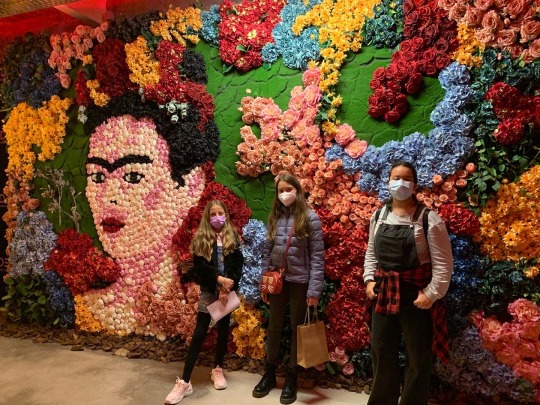
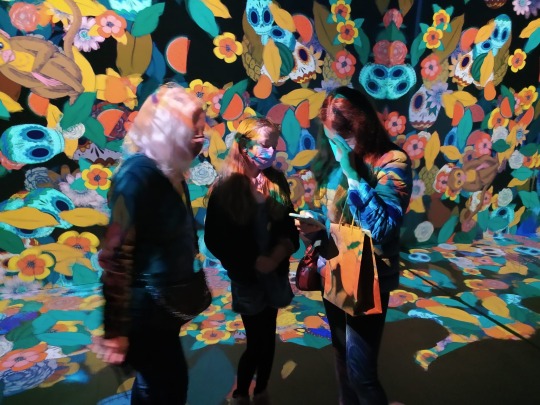
Frida was amazing prolific and the team at Ideal did a great job mixing her art into multi-media presentations. According to Wikipedia:
“Magdalena Carmen Frida Kahlo y Calderón (July 6 1907 – 13 July 1954) was a Mexican painter known for her many portraits, self-portraits, and works inspired by the nature and artifacts of Mexico. Inspired by the country's popular culture, she employed a naïve folk art style to explore questions of identity, postcolonialism, gender, class, and race in Mexican society. Her paintings often had strong autobiographical elements and mixed realism with fantasy. In addition to belonging to the post-revolutionary Mexicayotl movement, which sought to define a Mexican identity, Kahlo has been described as a surrealist or magical realist.She is also known for painting about her experience of chronic pain.”
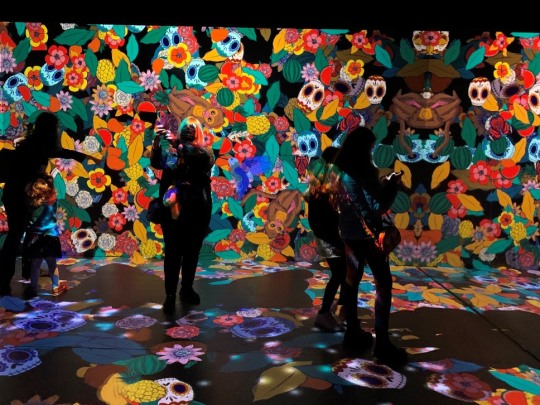
“Born to a German father and a mestiza mother, Kahlo spent most of her childhood and adult life at La Casa Azul, her family home in Coyoacán – now publicly accessible as the Frida Kahlo Museum. Although she was disabled by polio as a child, Kahlo had been a promising student headed for medical school until being injured in a bus accident at the age of 18, which caused her lifelong pain and medical problems. During her recovery, she returned to her childhood interest in art with the idea of becoming an artist.”
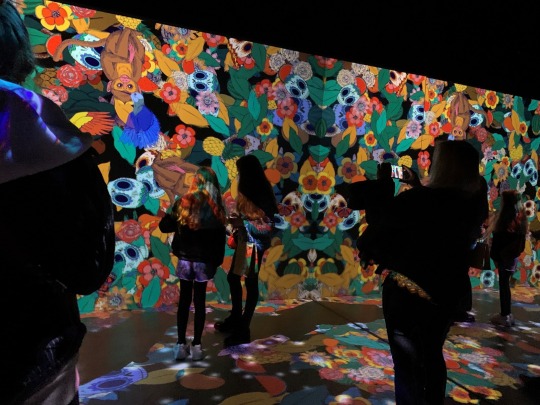
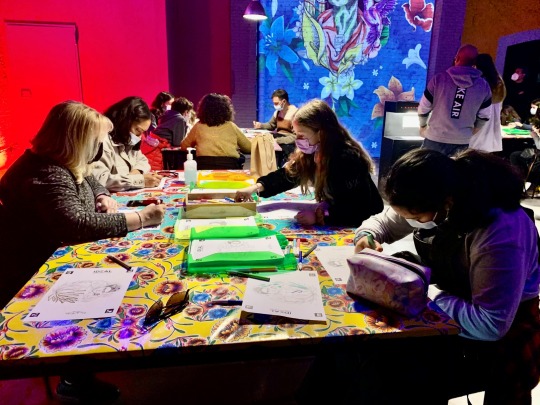
We were invited to tap into our creativity by coloring some of Frida’s art ourselves. The girls and mothers all got into the mood and we had a great time expressing ourselves.
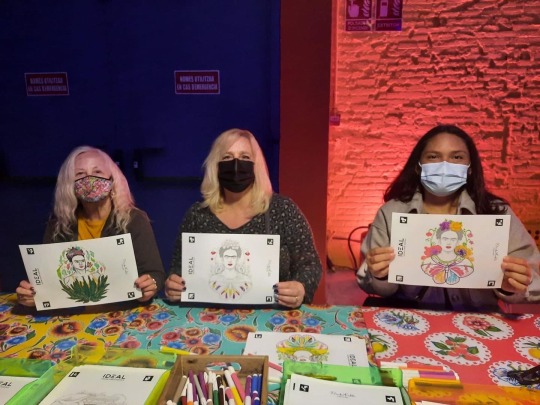
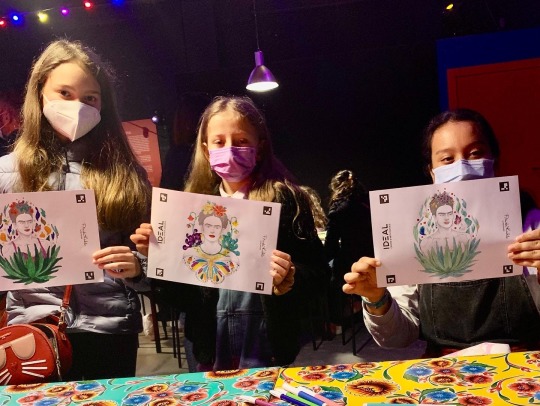
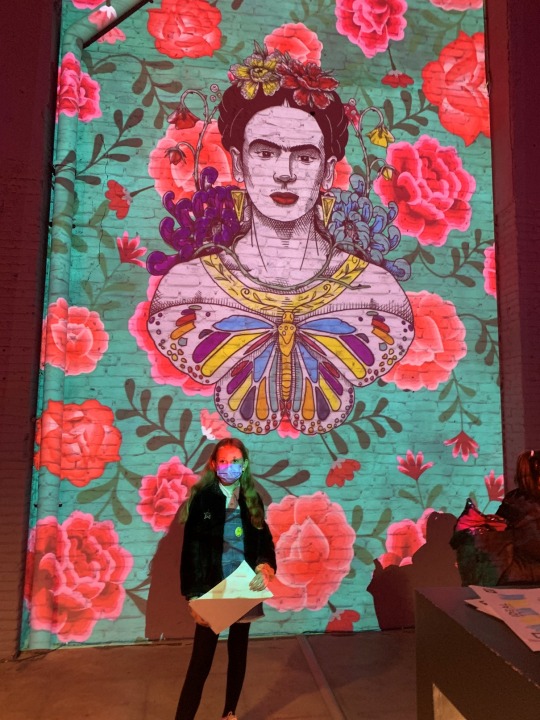
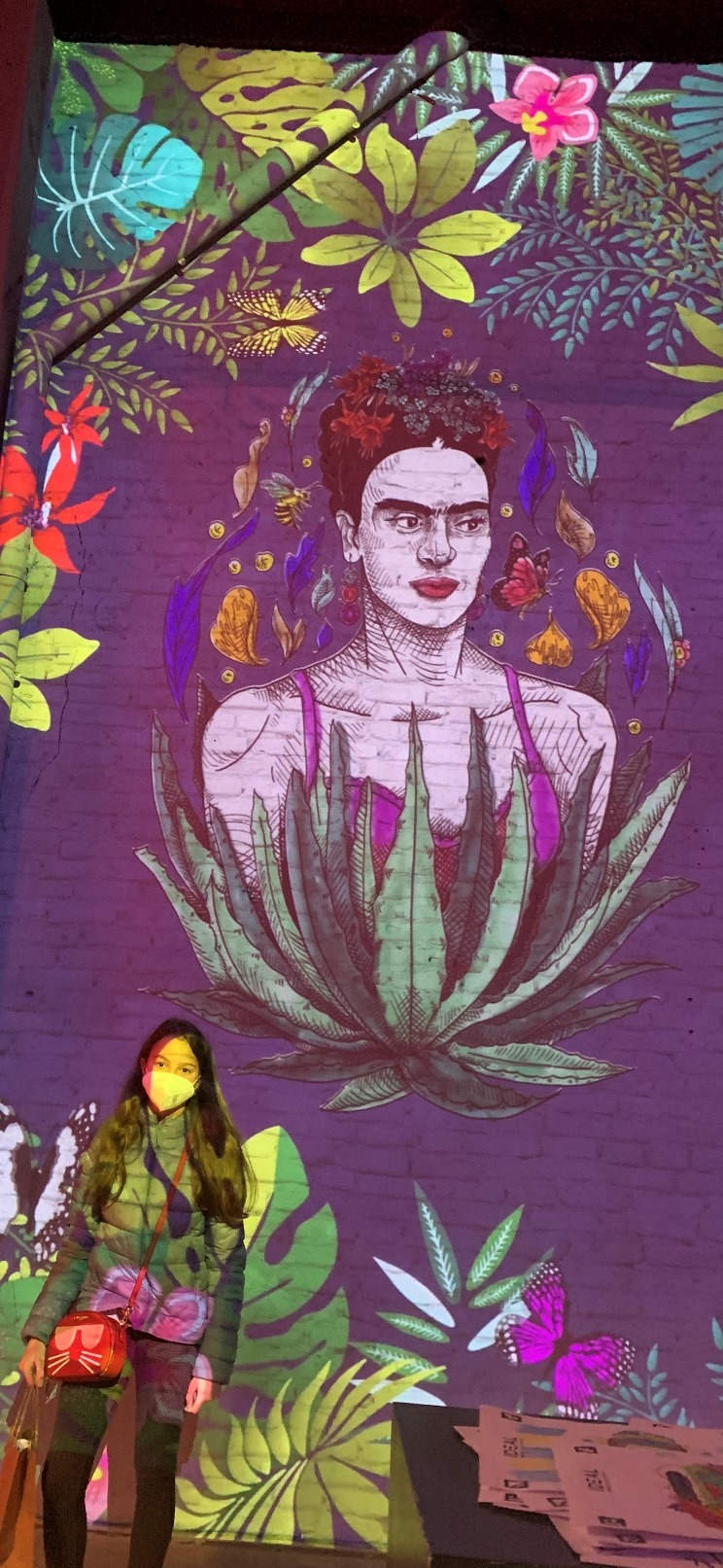
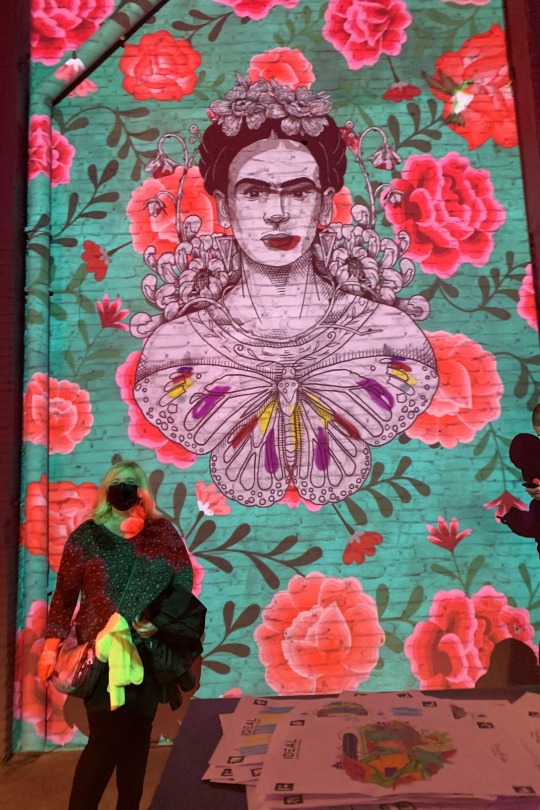

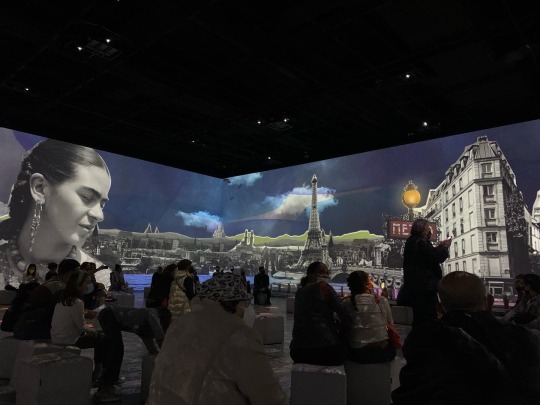
The Ideal space is large and the videos they create are awesome and display on the walls of the theater so we felt immersed in Frida’s world. From Wikipedia again:
“Kahlo's interests in politics and art led her to join the Mexican Communist Party in 1927, through which she met fellow Mexican artist Diego Rivera. The couple married in 1929 and spent the late 1920s and early 1930s travelling in Mexico and the United States together. During this time, she developed her artistic style, drawing her main inspiration from Mexican folk culture, and painted mostly small self-portraits that mixed elements from pre-Columbian and Catholic beliefs.”
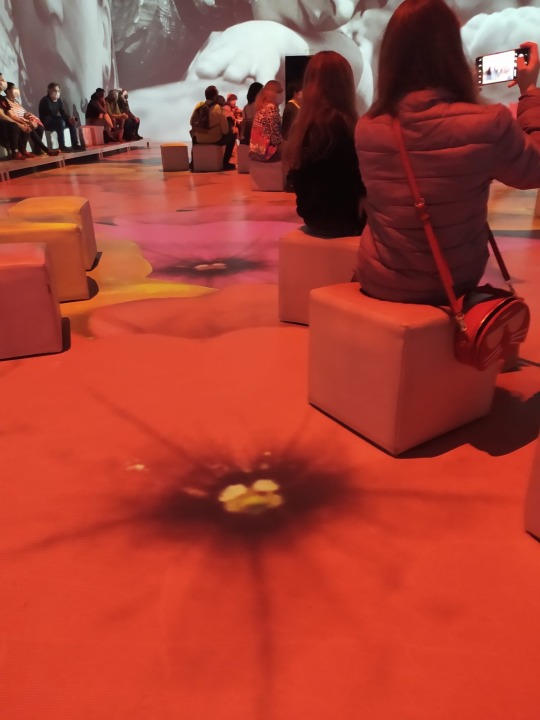

“Her paintings raised the interest of Surrealist artist André Breton, who arranged for Kahlo's first solo exhibition at the Julien Levy Gallery in New York in 1938; the exhibition was a success and was followed by another in Paris in 1939. While the French exhibition was less successful, the Louvre purchased a painting from Kahlo, The Frame, making her the first Mexican artist to be featured in their collection. Throughout the 1940s, Kahlo participated in exhibitions in Mexico and the United States and worked as an art teacher. She taught at the Escuela Nacional de Pintura, Escultura y Grabado ("La Esmeralda") and was a founding member of the Seminario de Cultura Mexicana. Kahlo's always-fragile health began to decline in the same decade. She had her first solo exhibition in Mexico in 1953, shortly before her death in 1954 at the age of 47.”
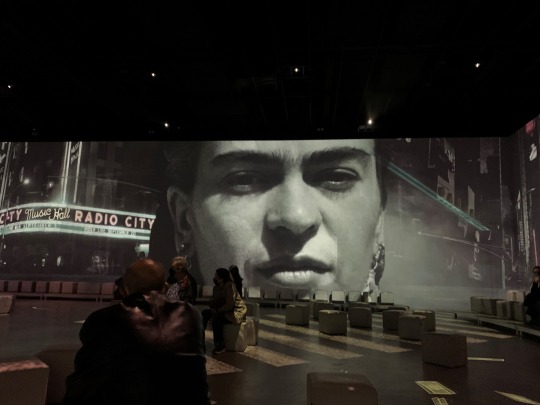
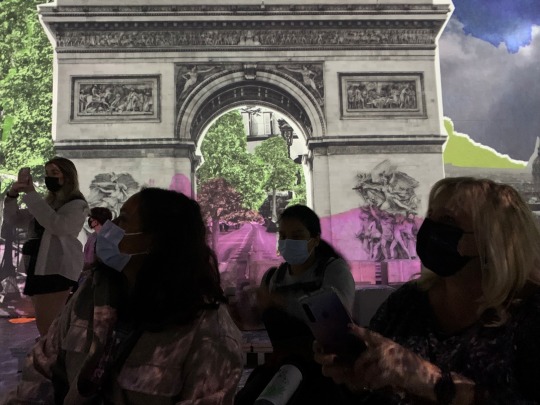
“Kahlo's work as an artist remained relatively unknown until the late 1970s, when her work was rediscovered by art historians and political activists. By the early 1990s, not only had she become a recognized figure in art history, but she was also regarded as an icon for Chicanos, the feminism movement, and the LGBTQ+ community. Kahlo's work has been celebrated internationally as emblematic of Mexican national and indigenous traditions and by feminists for what is seen as its uncompromising depiction of the female experience and form.”
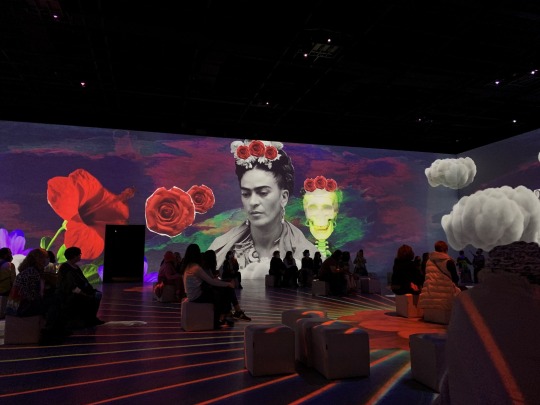

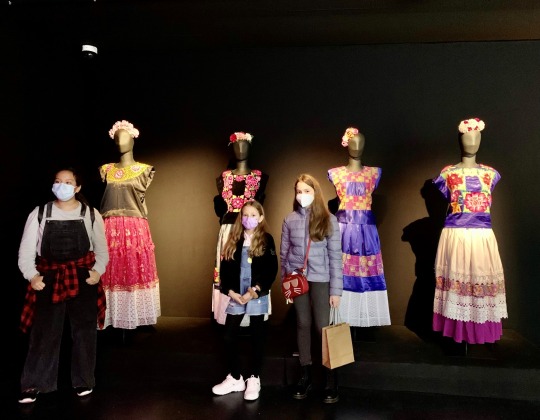
Frida also designed clothing and her designs were as colorful as her art.
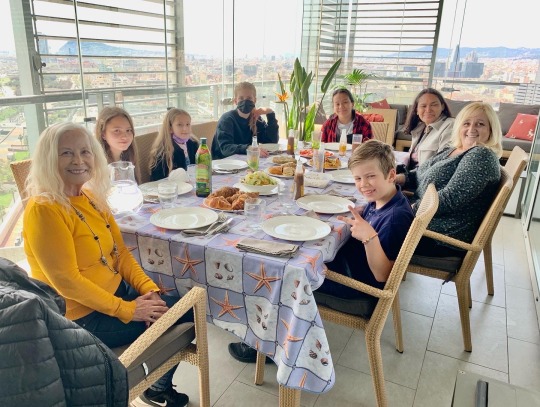
After the exhibition we went back to our place where Eva and her children, Laia and Oriol, were waiting for us to have lunch with them on our terrace.
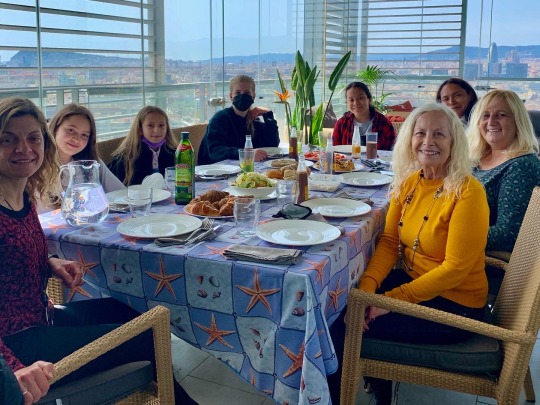
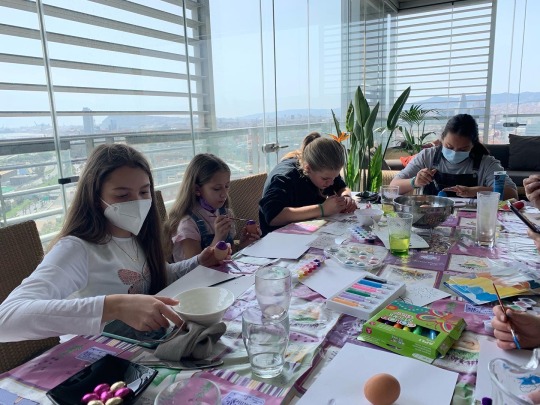
Then the kids got a chance to be creative again, this time painting Easter eggs. They all seemed to have fun and their eggs were all very different.
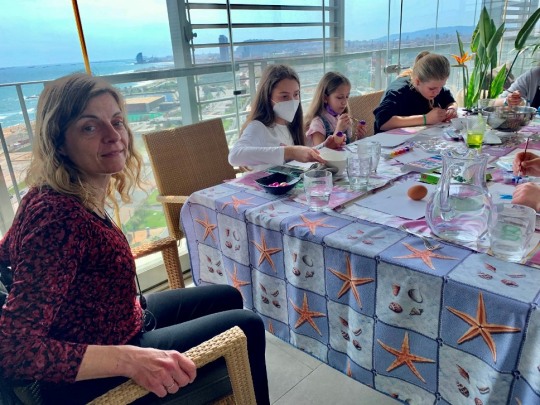
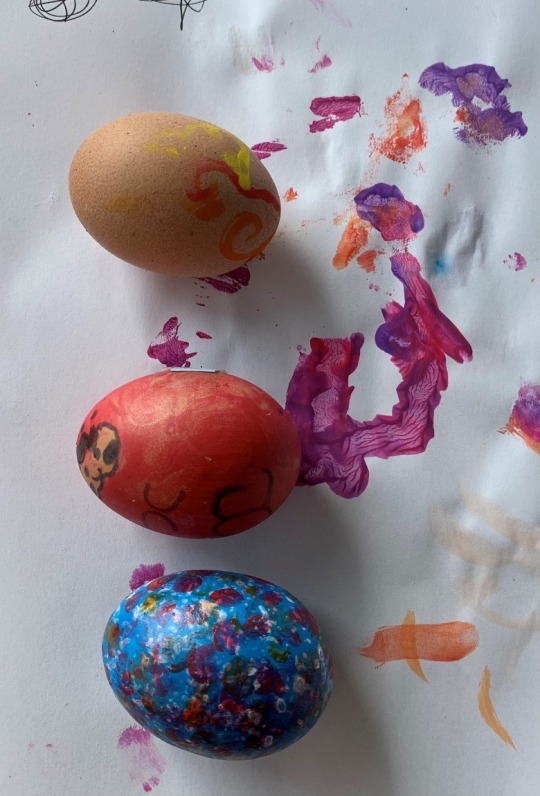

0 notes
Text
Bibliografía y webgrafía
https://fotonoviembre.org/
https://fotonoviembre.org/fotonoviembre-2021/mediateca/
http://teresaarozena.net/index.php?/articles-/
http://www.americansuburbx.com/
https://e-lur.net/
https://kbr.fundacionmapfre.org/
https://ajuntament.barcelona.cat/lavirreina/es
http://strobist.blogspot.com/
https://www.dpreview.com/
https://luminous-landscape.com/
Básica:
AROZENA, Teresa (Ed.): "Dispositivos de la fotografía. Archivo y relato en la visualidad contemporánea”. Publicación del Seminario XVI Bienal Internacional de Fotografía Fotonoviembre 2021. ISBN: 978-84-124928-5-9.
BARTHES, Roland: La cámara lúcida. Nota sobre la fotografía, Gustavo Gili, Barcelona, 1982.
BENJAMIN, Walter: Sobre la fotografía, Pre-textos, 2005. ·
MELLADO, José María. Fotografía digital de alta calidad, Artual, Barcelona 2006.
SONTAG, Susan: Sobre la fotografía, Edhasa, Barcelona, 1981. ·
VARIOS AUTORES. Enciclopedia focal de la fotografía, Omega, Barcelona, 1975, 3a edición
VARIOS AUTORES. La imagen fotográfica. Akal, Madrid, 2007. Complementaria:
BRIGHT, Susan: Fotografía hoy, Nerea, 2005.
DUBOIS, Philippe: El acto fotográfico. De la representación a la recepción, Paidós, Barcelona, 1986.
EGUIZABAL, Raúl: Fotografía publicitaria, Cátedra, Madrid 2001.
FLUSSER, Villem: Una filosofía de la fotografía, Síntesis, Madrid, 2001.
FONTCUBERTA, Joan.: El beso de Judas. Fotografía y verdad, Gustavo Gili, Barcelona 2002.
FONTCUBERTA, Joan. Estética fotográfica, Blume, Barcelona, 1984.
JACOBSON, Ralphe.: Manual de fotografía. Omega, Barcelona 1996
LANGFORD, Michael: Tratado de fotografía. Omega, Barcelona 1999.
PICAUDÉ, Valérie y ARBAÏZAR, Philippe: La confusión de los géneros en fotografía, Gustavo Gili, Barcelona, 2004.
PRÄKEL, David: Principios de fotografía creativa aplicada, Gustavo Gili, Barcelona, 2011.
RIBALTA, Jorge (eds.): Efecto real, debates postmodernos sobre la fotografía, Gustavo Gili, Barcelona, 2004.
RODRÍGUEZ, Hugo: La imagen Digital. Conceptos básicos. Marcombo, Barcelona, 2009.
SHORE, Stephen: Lección de fotografía. La naturaleza de las fotografías, Phaidon, Barcelona, 2009.
SHORT, Maria: Contexto y narración en fotografía, Gustavo Gili, Barcelona, 2013. T
AYLOR-HAW, Calvey: La iluminación en el estudio fotográfico, Omega, Barcelona, 2009.
VARIOS AUTORES: Vitamin Ph. New Perspectives in Photography, Phaidon, 2006.
0 notes
Text
Laetitia Ky artista che crea sculture coi capelli
https://www.unadonnalgiorno.it/laetitia-ky-artista-che-crea-opere-darte-con-i-suoi-capelli/
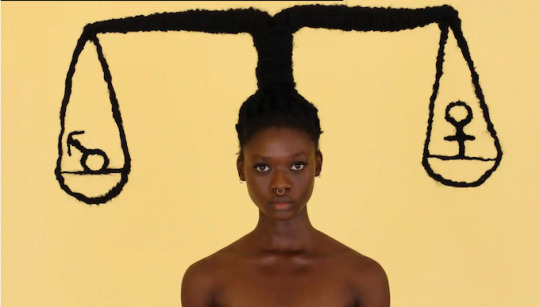
Con la colonizzazione francese si è imposta la moda occidentale, quindi le donne ivoriane hanno iniziato a farsi i capelli lisci. Per me invece non va nascosta la nostra natura, è un elemento di blackbeauty. Vedersi rappresentate con le acconciature afro senza paura è un passo in avanti.
Laetitia Ky è un’artista, modella e attivista che crea sculture con i suoi capelli.
È una figura di spicco nel movimento naturale dei capelli, che, dagli anni sessanta, rivendica politicamente e simbolicamente le proprie radici, rifiutando di adeguarsi ai canoni estetici delle donne occidentali.
Nelle sue opere, i suoi capelli, svettano sulla sua testa rappresentando di volta in volta mani, braccia muscolose, volti con il pugno alzato, elefanti, seni e ventri femminili. Creazioni che costituiscono un potente strumento di comunicazione concepito per aumentare la consapevolezza sui temi della razza, del genere e della giustizia sociale. Elementi di identità nazionale, reinterpretati in chiave contemporanea.
Nata nel 1996 ad Abidjan, Costa d’Avorio, nonostante una laurea in economia, ha deciso di dedicarsi all’arte piuttosto che agli affari e ha iniziato a insegnare a cucire da sola, con l’intento di intraprendere una carriera nella moda.
Ha iniziato da giovanissima a interessarsi al movimento americano dei capelli naturali, praticamente ancora inesistente negli stati dell’Africa sub-sahariana, tranne rarissime eccezioni di qualche attivista.
Nel 2016, dopo aver visto online un album fotografico di donne africane pre-coloniali del ventesimo secolo, è stata ispirata a scolpire i suoi capelli in un modo simile a loro e ha pubblicato le sue sculture su Instagram che sono state di grande ispirazione.Nel 2017, i suoi post erano ormai virali, ha attirato l’attenzione di riviste internazionali e tenuto il suo primo seminario Ky Braids per insegnare la sua forma d’arte, l’anno successivo, ha lanciato il marchio di moda
Kystroy,
che utilizza la body positivity per descrivere i suoi capi.
L’oppressione basata sul sesso è un tema ricorrente della sua arte, ha realizzato sculture di protesta contro pratiche come l’appiattimento del seno, le mutilazioni genitali femminili e le leggi americane contro l’aborto.
Ogni acconciatura è un viaggio nuovo, diverso, che può durare pochi minuti o diverse ore, e che l’artista intraprende utilizzando solamente del fil di ferro legato ai suoi capelli naturali.
Nel 2018 è stata inclusa tra le 35 persone più influenti sotto i 35 anni del Prix Jeunesse Francophone.
L’anno seguente è elencata tra le cento persone di rilievo per la rivista Paper.
Ha anche recitato nel film Disco boy di Giacomo Abbruzzese, che ha vinto l’Orso d’argento a Berlino.
Laetitia Ky è un’artista poliedrica che, attraverso il suo lavoro, denuncia le metamorfosi dei corpi esplorando temi delicati e scomodi.
Nel 2022 è stata la più giovane protagonista della Biennale di Venezia, dove ha rappresentato la Costa d’Avorio e tra le cento artiste invitate dal Kunstmuseum di Wolfsbur per l’epocale mostra Empowerment dedicata al femminismo nell’arte.
1 note
·
View note
Text
Lovecraft Country, Episode 7, Season 1, “I Am.”
With Hippolyta voyage's and her dimensional experience we meet:
Bessie Springfield (1911 or 1912 - 1993)
Bessie Stringfield (1911 or 1912 – February 16, 1993) was an American motorcyclist who was the first African-American woman to ride across the United States solo, and was one of the few civilian motorcycle dispatch riders for the US Army during World War II. Credited with breaking down barriers for both women and Jamaican-American motorcyclists, Stringfield was inducted into the Motorcycle Hall of Fame. The award bestowed by the American Motorcyclist Association (AMA) for "Superior Achievement by a Female Motorcyclist" is named in her honor.
Frida Kahlo (1907 - 1954)
Magdalena Carmen Frida Kahlo y Calderón (6 July 1907 – 13 July 1954) was a Mexican painter known for her many portraits, self-portraits, and works inspired by the nature and artifacts of Mexico. Inspired by the country's popular culture, she employed a naïve folk art style to explore questions of identity, postcolonialism, gender, class, and race in Mexican society. Her paintings often had strong autobiographical elements and mixed realism with fantasy. In addition to belonging to the post-revolutionary Mexicayotl movement, which sought to define a Mexican identity, Kahlo has been described as a surrealist or magical realist.
Born to a German father and a mestiza mother, Kahlo spent most of her childhood and adult life at La Casa Azul, her family home in Coyoacán – now publicly accessible as the Frida Kahlo Museum. Although she was disabled by polio as a child, Kahlo had been a promising student headed for medical school until she suffered a bus accident at the age of eighteen, which caused her lifelong pain and medical problems. During her recovery she returned to her childhood hobby of art with the idea of becoming an artist.
Kahlo's interests in politics and art led her to join the Mexican Communist Party in 1927, through which she met fellow Mexican artist Diego Rivera. The couple married in 1929, and spent the late 1920s and early 1930s travelling in Mexico and the United States together. During this time, she developed her artistic style, drawing her main inspiration from Mexican folk culture, and painted mostly small self-portraits which mixed elements from pre-Columbian and Catholic beliefs. Her paintings raised the interest of Surrealist artist André Breton, who arranged for Kahlo's first solo exhibition at the Julien Levy Gallery in New York in 1938; the exhibition was a success, and was followed by another in Paris in 1939. While the French exhibition was less successful, the Louvre purchased a painting from Kahlo, The Frame, making her the first Mexican artist to be featured in their collection. Throughout the 1940s, Kahlo participated in exhibitions in Mexico and the United States and worked as an art teacher. She taught at the Escuela Nacional de Pintura, Escultura y Grabado ("La Esmeralda") and was a founding member of the Seminario de Cultura Mexicana. Kahlo's always-fragile health began to decline in the same decade. She had her first solo exhibition in Mexico in 1953, shortly before her death in 1954 at the age of 47.
Kahlo's work as an artist remained relatively unknown until the late 1970s, when her work was rediscovered by art historians and political activists. By the early 1990s, she had become not only a recognized figure in art history, but also regarded as an icon for Chicanos, the feminism movement and the LGBTQ+ movement. Kahlo's work has been celebrated internationally as emblematic of Mexican national and indigenous traditions and by feminists for what is seen as its uncompromising depiction of the female experience and form.
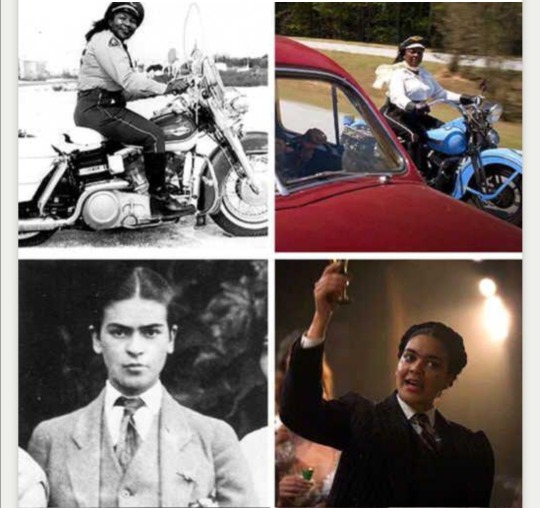
Josephine Baker (1906 - 1975)
Josephine Baker (born Freda Josephine McDonald, naturalised French Joséphine Baker; 3 June 1906 – 12 April 1975) was an American-born French entertainer, French Resistance agent, freemason and civil rights activist. Her career was centered primarily in Europe, mostly in her adopted France. She was the first Black woman to star in a major motion picture, the 1927 silent film Siren of the Tropics, directed by Mario Nalpas and Henri Étiévant.
During her early career Baker was renowned as a dancer, and was among the most celebrated performers to headline the revues of the Folies Bergère in Paris. Her performance in the revue Un vent de folie in 1927 caused a sensation in Paris. Her costume, consisting of only a short skirt of artificial bananas and a beaded necklace, became an iconic image and a symbol of the Jazz Age and the Roaring Twenties.
Baker was celebrated by artists and intellectuals of the era, who variously dubbed her the "Black Venus", the "Black Pearl", the "Bronze Venus", and the "Creole Goddess". Born in St. Louis, Missouri, she renounced her U.S. citizenship and became a French national after her marriage to French industrialist Jean Lion in 1937. She raised her children in France. "I have two loves, my country and Paris", Baker once said, and she sang: " J'ai deux amours, mon pays et Paris ".
She was known for aiding the French Resistance during World War II. After the war, she was awarded the Croix de guerre by the French military, and was named a Chevalier of the Légion d'honneur by General Charles de Gaulle.
Baker refused to perform for segregated audiences in the United States and is noted for her contributions to the civil rights movement. In 1968, she was offered unofficial leadership in the movement in the United States by Coretta Scott King, following Martin Luther King Jr.'s assassination. After thinking it over, Baker declined the offer out of concern for the welfare of her children.
Nawi, the last Dahomei Amazon (1879 - 1979)
The Dahomai Amazons were female warriors who left European colonisers shaking in their boots, foreign observers named them the Dahomey Amazons while they called themselves N’Nonmiton, which means “our mothers”. Protecting their king on the bloodiest of battlefields, they emerged as an elite fighting force in the Kingdom of Dahomey in, the present-day Republic of Benin. Described as untouchable, sworn in as virgins, swift decapitation was their trademark.
The last surviving Amazon of Dahomey died at the age of 100 in 1979, a woman named Nawi who was discovered living in a remote village. At their height, they made up around a third of the entire Dahomey army; 6,000 strong, but according to European records, they were consistently judged to be superior to the male soldiers in effectiveness and bravery.
Even after French expansion in African in 1890s subdued the Dahomey people, their reign of fear continued. Uniformed French soldiers who took Dahomey women to bed were often found dead in the morning, their throats slit open. During the Franco-Dahomean Wars, many of the French soldiers fighting in Dahomey had hesitated before shooting or bayoneting the N’Nonmiton. Underestimating their female opponents led to many of the French casualties as special units of the female Amazons were assigned specifically to target French officers.
By the end of the Second Franco-Dahomean War, the French prevailed, but only after bringing in the Foreign Legion, armed with machine guns. The last of the King’s force to surrender, most of the Amazons died in the 23 battles fought during the second war. The legionnaires later wrote about the “incredible courage and audacity” of the Amazons.
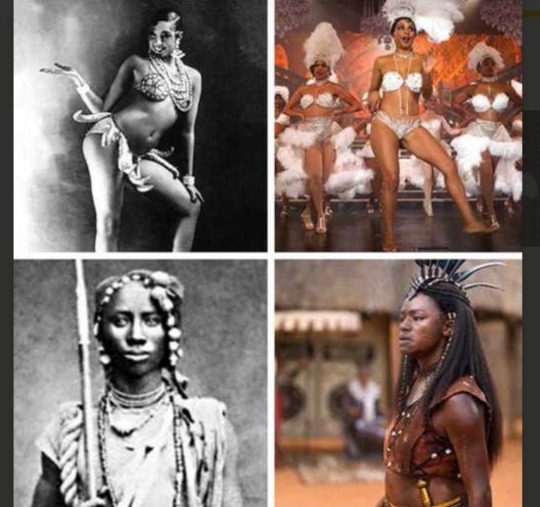
#vavuskapakage#lovecraft country#frida kahlo#bessie stringfield#josephine baker#nawi#hippolyta freeman#i am hippolyta#vavuskabooks
23 notes
·
View notes
Text
Llega una nueva edición del Seminario ACSOJA
Los días 21 y 22 de septiembre próximos, ACSOJA llevará a cabo una nueva edición de su Seminario anual, Seminario ACSOJA 2021, en el que se abordará la actualidad del cultivo de soja en la Argentina y en el mundo. El mismo se realizará vía streaming.

Por sexto año, la Asociación de la Cadena de la Soja Argentina- ACSOJA, organiza el Seminario ACSOJA 2021, un encuentro clave para continuar potenciando el desarrollo de la cadena de soja. En momentos difíciles, desde muchos puntos de vista, que condicionan el crecimiento, debemos retomar la producción sustentable de la mayor fuente exportadora del país, con un impulso a la aplicación de tecnologías en un marco de una menor presión impositiva tan necesaria.
Este año será una edición especial, bajo la modalidad virtual, de acceso libre y gratuito, a realizarse en dos jornadas, los días martes 21 y miércoles 22 de septiembre próximos.
Con la representatividad de cada uno de los eslabones, y el objetivo de abarcar toda la Cadena de la Soja, desde el grano hasta los subproductos derivados del cultivo con valor agregado, la VI edición del Seminario convocará a prestigiosos profesionales de las más diversas y especializadas materias y a importantes referentes políticos que compartirán su trabajo en el sector, y de los cuales tendremos su visión sobre los objetivos planteados para el crecimiento de la cadena de soja, generando un debate claro y productivo.
A través de la web del Seminario, www.seminarioacsoja.org.ar, se podrá ingresar a la información destacada y al auditorio donde transcurrirán los diferentes paneles, divididos en 3 grandes bloques, con los siguientes ejes temáticos: “Tecnología en soja” y “Potenciar la soja”, ambos a desarrollarse en el primer día, y “Agroindustria y economía”, que se tratará en la segunda jornada.
“Considerando el rol decisivo que cumple la región en la producción mundial de soja y en su comercialización, es que concebimos esta edición especial de nuestro evento anual, que ya se ha transformado en un espacio de referencia para la construcción de valor, a través del conocimiento y las relaciones entre todos los actores de la cadena de la soja. Los invitamos a ser parte de este encuentro para seguir debatiendo temas claves para este cultivo, de la mano de especialistas de los ámbitos público y privado, de Argentina y el mundo”, comentó Luis Zubizarreta, presidente de ACSOJA.
Los contenidos de cada día
El martes 21 de septiembre, el primer Bloque “Tecnología en soja”, dará inicio aproximadamente a las 8.30 hs., con la apertura del Seminario, que estará a cargo del presidente de la entidad, junto a autoridades de los gobiernos de Rosario, Santa Fe y Nacional.
Luego, en el Panel “Situación regional en la producción de soja”, especialistas de diferentes regiones del país expondrán los principales aspectos tecnológicos vinculados a la producción de soja.
Además, tendrá lugar el Panel “Fertilizar la soja, un compromiso frente a la sustentabilidad”, donde diversas empresas presentarán su visión sobre este tema. Estamos con niveles muy bajos en el uso de esta práctica en soja, y es hora de analizar las limitantes que la condicionan, contando con productos excelentes y alta tecnología de manejo de nutrientes.
A continuación, se desarrollará el Panel “Enlist; celebramos la nueva tecnología”, en el que se expondrán las características de la tecnología Enlist en soja y las empresas presentarán las nuevas variedades que estarán disponibles en esta campaña y su manejo.
Potenciar la soja
Por la tarde, al finalizar un receso, se desarrollará este segundo eje, comenzando con el Panel: “Los millennials de la soja”, en el que estudiantes compartirán sus tesis sobre investigaciones novedosas para el cultivo. Conoceremos a los autores, sus motivaciones y cómo ven el futuro para sus carreras que se inician.
Otro de los Paneles será: “Cómo comunica la Cadena de Soja en el mundo”, en el que se presentará la visión de expertos de distintos países de la región, sobre la comunicación hacia la sociedad y los decisores del Estado. Tendremos representantes de EE.UU., y los países del Mercosur, coordinados por un especialista.
Al cierre de la primera jornada, aprox. a las 17 hs., se realizará el Panel “Cadenas globales de valor”, con la participación de miembros de entidades del sector. La nueva situación frente a la pandemia, sus consecuencias y los compromisos frente a las grandes directivas que se manejan en el abastecimiento de alimentos serán el eje de las presentaciones.
El miércoles 22 de septiembre, la segunda jornada virtual del Seminario ACSOJA 2021, será sobre el eje “Agroindustria y economía” y comenzará a las 9 hs, con el Panel “Panorama de la soja argentina”, en el que se darán a conocer las perspectivas de la oferta y demanda global para la soja 2021/22.
Luego, se hará el Panel “Seguros, financiación y coberturas: cómo protegerse en un contexto cambiante”.
Por último, alrededor de las 11.45 hs, se realizará el Panel final del Seminario, en el que se debatirá qué piensan de la soja los referentes políticos de las principales provincias argentinas.
El Seminario ACSOJA 2021 cuenta con el apoyo: Corteva y Sistema Enlist, Atanor, Basf, Bayer, Brevant, Fusion, Greenlab, Nitrap, Pioneer, Pla, Williams Agroservicios, Bioceres Semillas, Banco Galicia, Rizobacter, Sancor Seguros, Matba Rofex, Spraytec, Quimeco, Adama, Don Mario, Bunge y Nutrien Ag Solutions.
El evento es de acceso libre y gratuito y requiere de inscripción previa.
Para mayor información y/o pre inscripción al encuentro virtual, contactarse a [email protected], y próximamente ingresando a www.seminarioacsoja.org.ar
Acerca de la Asociación de la Cadena de la Soja Argentina (ACSOJA)
La Cadena de la Soja Argentina – ACSOJA, es una Asociación sin fines de lucro que está integrada por los seis sectores que componen la Cadena: investigación, insumos, producción, comercialización, industrialización y servicios y nuestros socios plenarios son las organizaciones, bolsas de comercio y cereales, instituciones y cámaras con mayor representatividad dentro de la actividad. Actualmente ACSOJA suma más de 30 entidades privadas y públicas como el INTA y Universidades.
Se constituyó en 2004 por iniciativa de representantes de algunos de los sectores más significativos con el propósito de “consolidar lo hecho y proyectar un futuro común” con situaciones internas y externas cambiantes e imprevisibles a las cuales se domina y enfrenta con el conocimiento que se genera desde el conjunto. De esta manera, es posible diseñar estrategias de mediano y largo plazo para hacer competitivos a cada uno de los grandes sectores que hilvanan esta verdadera cadena productiva.
www.acsoja.org.ar
https://www.facebook.com/acsoja/
https://www.instagram.com/acsoja/
https://twitter.com/acsoja_arg
Contacto de Prensa Seminario ACSOJA 2021
Paula Vázquez
MASCOM
1 note
·
View note
Photo
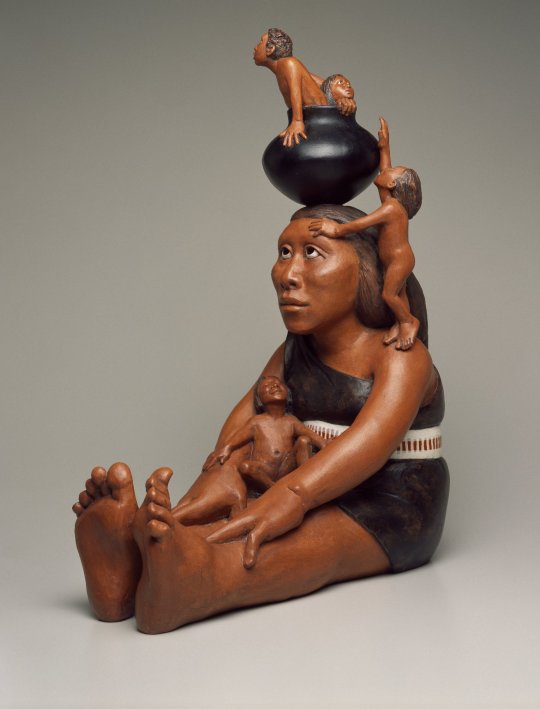
Stronger Together
Hi Brooklyn. We hope you and your loved ones are safe and healthy. The times are difficult and it is valid if you may not feel your best. It is okay to feel your feelings, and take your time to heal during these moments. As you navigate these difficult times, remember that you are a part of the community that is here to support you. The Brooklyn, and New York community at large, is one of the most vibrant and resilient there is!
If you have questions, or have more you wish to see or to spotlight, reach out. We want to hear from you. Please email [email protected].
Also, text 'COVID' to 692-692 to get important COVID-19 related updates sent straight to your phone. You can text 'COVIDESP' to get updates in Spanish.
Local Business Highlights of the Week:
Oxalis is temporarily closed for service, but will offer pick up and delivery on Friday, Saturday and Sundays from 4pm-8pm of fresh and prepared foods, cocktails and wine. Place your order, or pre order at www.boxalis.com , by phone at (347) 627-8298 or by email at [email protected]
No-frills Korean flavors are still being served at the famed Kimchi Taco. Take out and no-contact delivery available from 12-10pm daily.
Census
A reminder to complete the 2020 Census today at my2020census.gov.
In this webinar, you will learn about the guiding principles the Census Bureau is implementing for the use of administrative records and research findings for the housing and demographic questions on the survey.
On May 12th, United Way is launching United We Count, United We Vote – a civic engagement campaign to mobilize people in civic participation and collective action during this time of uncertainty and social distancing. Register for the event here.
For literature on the 2020 Census and how it may affect your community, check out the reading below:
How Changes to the 2020 Census Timeline Will Impact Redistricting
Census in a Time of COVID-19: What can we do as individuals?
Resources for children and families
COVID-19 has dramatically changed our lives. All New Yorkers deserve to celebrate, honor, and memorialize their loved ones. Get funeral & burial guidance from the City of New York.
If your work schedule was reduced as a result of the coronavirus and you are unable to pay your rent, you can apply for a Cash Assistance special grant request to get benefits for emergencies.
The City of New York's COVID-19 Hotel Program provides free hotel stays to eligible New Yorkers who cannot isolate where they live and frontline workers in the healthcare industry who wish to reduce the risk of transmission at home. This will help New York City stop the spread of COVID-19.
Scholastic Learn At Home allows open access to daily learning journeys divided into four grade spans—Pre-K–K, Grades 1–2, Grades 3–5, and Grades 6–9+, covering ELA, STEM, Science, Social Studies, and Social-Emotional Learning.
CORE: CHILDREN OF RESTAURANT EMPLOYEES is dedicated to serving food and beverage service employees with children, who are faced with a health crisis or a natural disaster and are in need of support and in need of our help. If you have been diagnosed with COVID-19, you can apply here.
Resources for artists, freelancers, and gig workers
Rauschenberg Emergency Grant Program provides one-time grants to artists of up to $5,000 for unexpected medical emergencies.
Max’s Emergency Relief & Resource Fund is a one-time grant award of between $500-$1000 ($1,000 when funds are available) to assist artists in all art disciplines who have a steady work history, but who are experiencing a temporary financial set back. Visit their application here.
In light of the impact of the COVID-19 pandemic on the artist community, on March 18 Foundation for Contemporary Arts launched the FCA Emergency Grants COVID-19 Fund. To find out your eligibility, click here.
Science Fiction and Fantasy Writers of American have developed an Emergency Fund to help genre writers pay medical expenses not otherwise covered by insurance. Visit their website for more information.
Employment Resources
New York State is waiving the 7-day waiting period for Unemployment Insurance benefits for people who are out of work due to Coronavirus (COVID-19) closures or quarantines. Visit the New York State Department of Labor (DOL) website for more information.
The New York State Worker Adjustment and Retraining Notification (WARN) Act requires businesses to give early warning of closing and layoffs. More information for business is available from the New York State Department of Labor.
Find Employment through Virtual Workforce Career Center online. The Virtual Workforce1 Career Center system connects New Yorkers, via web or phone, to one-on-one help from professionals who can help.
NY Job Listings during Quarantine organized by Davide Chen.
PTFB is offering assistance in finding employment at Northwell Health for FOH/BOH foodservice and housekeeping positions. Find out how to apply here.
Resources for the Undocumented Community
List of Resources for Undocumented People in NYC may be located here. Document is translated in three languages, English, Spanish and Portuguese.
For more information regarding DACA, check out Informed Immigrants.
CUNY Citizenship will be live, May 13th at 12:00PM on Facebook with Shawn Rahman, Managing Attorney for Training and Capacity Building with the latest immigration updates.
Contact Jesus Perez if you are an undocumented student at Brooklyn College who needs support via email: [email protected] or phone: 718.951.5023
Funding Opportunities
The Carroll and Milton Petrie Student Emergency Grant Fund was created to provide eligible students facing short-term, nonrecurring emergencies with a one-time grant to alleviate the situation. To find if you are eligible, visit the Brooklyn College’s Website.
Volunteer or Participation Resources
The NYC Network of Worker Cooperatives has joined the national #ShareMyCheck campaign to encourage those in a relatively stable position to donate all or a portion of their check to people who are not eligible for these checks - those that are historically and contemporarily most impacted by economic and health crises.
LGBTQ+ Resources
Ohher Publishing angels is offering $50 relief funds for trans/non-binary/two spirt people of color who are in need of community support right now. To learn more, visit Leste Magazine.
Trans Lifeline is a trans-led organization that connects trans people to the community, support, and resources they need to survive and thrive. If you are in need of mental health assistance, visit their website here.
Upcoming Webinars
Tuesday, May 12: 2:00PM-3:30 PM: Brookings’ Reopening the Coronavirus-Closed Economy
Wednesday, May 13, 6:00PM-7:00PM: Make The Road New York will host a Seminario Web De Estudio Comunitario (community study webinar) on Facebook live.
Thursday, May 14, 2020 4:00pm-7:00pm: New York City Network of Worker Cooperatives is hosting a COVID-19 Health Awareness Training. The goal of this program is to Increase health and safety awareness for workers in industries with potential exposure to COVID-19.
Remember to Follow Our Elected Officials For Up To Date News:
Stay up to date with information provided by Governor Cuomo. Follow our New York State governor on Twitter, Facebook and Instagram for up to date information regarding new health guidelines closures, and executive orders.
The Mayor has a new Daily Message available on Twitter, Facebook, Instagram and YouTube every morning. If your constituents have questions, comments or concerns, they want him to respond to, they can send them using the hashtag #AskMyMayor
The Office of the Brooklyn Borough President provides the most up-to-date information and resources to Brooklynites. Follow these pages regularly and follow Brooklyn Borough President Eric Adams on social media for real-time updates.
Congresswoman for the 9th District, Yvette D. Clark is working hard in Congress to support our local communities. Follow the Congresswoman on her Twitter to receive updates on what is going on in Washington DC and resources available in your ‘hood!
Follow updates and news from Council Member Laurie A. Cumbo on Facebook and Twitter. Cumbo serves as the Council Majority leader for Brooklyn’s 35th District- Fort Greene, Clinton Hill, Crown Heights, Prospect Heights and Bed-Stuy.
Follow New York City Council Member Robert E. Cornegy, representing Brooklyn 36th District- Bedford Stuyvesant and Northern Crown Heights on Twitter , Facebook, and Instagram for important updates regarding COVID-19 updates.
Check out New York City Council Member Brad Lander’s resource page aimed to help NYC-based freelancers and artists navigate these uncertain times. Have your voice heard, fill out the survey and explore what benefits might be available to you. Follow him on Twitter for important updates.
Follow updates from the NYC City Immigrant Affairs office on Twitter interested in renewing your DACA application form. Call ActionNYC at 1-800-354-0365.
Roxanne Swentzell (Kah'p'oo Owinge (Santa Clara Pueblo), born 1962). Making Babies for Indian Market, 2004. Clay, pigment. Brooklyn Museum, Gift in memory of Helen Thomas Kennedy, 2004.80. © artist or artist's estate
#covid#brooklynstrong#brooklyn#resources#communityresources#coronavirusresources#strongertogether#nyc#brooklyn museum#covid-19#community#coronavirus
52 notes
·
View notes
Photo

15 LGBT Legends from the past for 50 years of Stonewall 15/15: Frida Kahlo
Frida Kahlo (6 July 1907 – 13 July 1954) was a Bisexual Woman and Mexican artist who painted many portraits, self-portraits, and works inspired by the nature and artifacts of Mexico. Inspired by the country's popular culture, she employed a naïve folk art style to explore questions of identity, postcolonialism, gender, class, and race in Mexican society. Her paintings often had strong autobiographical elements and mixed realism with fantasy. In addition to belonging to the post-revolutionary Mexicayotl movement, which sought to define a Mexican identity, Kahlo has been described as a surrealist or magical realist. Kahlo's interests in politics and art led to the next stage of her life. In 1927, she joined the Mexican Communist Party, through which she met fellow Mexican artist Diego Rivera, whom she married in 1928. Kahlo spent the late 1920s and early 1930s travelling in Mexico and the United States with Rivera. During this time, she developed her artistic style, drew her main inspiration from Mexican folk culture, and painted mostly small self-portraits which mixed elements from pre-Columbian and Catholic beliefs. Her paintings raised the interest of Surrealist artist André Breton, who arranged for Kahlo's first solo exhibition at the Julien Levy Gallery in New York in 1938. The exhibition was a success and was followed by another in Paris in 1939. While the French exhibition was less successful, the Louvre purchased a painting from Kahlo, The Frame, making her the first Mexican artist to be featured in their collection. Throughout the 1940s, Kahlo participated in exhibitions in Mexico and the United States, and also worked as an art teacher. She taught at the Escuela Nacional de Pintura, Escultura y Grabado "La Esmeralda" and was a founding member of the Seminario de Cultura Mexicana. Kahlo's always fragile health began to decline in the same decade. She had her first solo exhibition in Mexico in 1953, shortly before her death in 1954 at the age of 47. Kahlo's work as an artist remained relatively unknown until the late 1970s, when her work was rediscovered by art historians and political activists. By the early 1990s, she had become not only a recognized figure in art history, but also regarded as an icon for Chicanos movement, the feminism movement and the LGBT movement. Kahlo's work has been celebrated internationally as emblematic of Mexican national and indigenous traditions and by feminists for what is seen as its uncompromising depiction of the female experience and form.
#frida kahlo#wlw#bisexual#bisexuality#lgbt#lgbt+#lgbtq#pride#pride month#feminism#feminist#communism#kahlo#diego rivera#mexico#mexican#ivansbadart#art#my art#digital art#Illustration#illustrator
142 notes
·
View notes
Text
Julius Evola - La SS, una Guardia y una Orden
El siguiente texto que hemos traducido de la versión inglesa, publicada por el sitio counter-currents.com en Septiembre de 2016, es el breve artículo "Le SS, Guardia e Ordine della Rivoluzione Crociuncinata" que presentó Julius Évola en la revista La Vita Italiana en Agosto de 1938. Se trata de una descripción y valoración de la organización alemana SS que estuvo bajo la dirección de Himmler, cuya formación y proyección podría constituír, pensaba Évola entonces, un substrato cultural y civilizacional del que podrían beneficiarse numerosas naciones contra la marea de fuerzas oscuras.

La SS, Guardia y Orden de la Revolución de la Esvástica por Julius Évola Agosto de 1938
Una de las más interesantes, significativas y quizá menos conocidas creaciones de la revolución nacionalsocialista alemana es el llamado cuerpo SS.
SS es una abreviatura de Schutz-Staffeln [Escuadrones de Protección], el cuerpo "negro" de defensa del Tercer Reich. Así como el ejército —la Reichswehr— es el órgano de la defensa externa del Estado, la SS es su órgano interno de defensa. En esta organización única se aúnan en una ordenada síntesis las características de una Orden antigua, de una élite política, de una élite biológica y heroica, de un cuerpo de guardias del Führer, de una "policía estatal secreta" en un sentido superior, y finalmente, de un grupo que pretende materializar y defender, en la manera más directa, las ideas básicas de la cosmovisión nacionalsocialista. Ella está compuesta por doscientos mil hombres, unidos por un juramento inquebrantable de lealtad y honor, quienes se ven a sí mismos —en palabras de su líder, el Reichsführer SS Heinrich Himmler— como "una Orden Nacionalsocialista de guerreros". Ellos aspiran a volver a los orígenes: ellos se esfuerzan por ser una comunidad en la cual el contacto renovado con las fuerzas originales de su raza y con los mitos de la gran civilización nórdica primordial forma el principio de una vida nueva e indomable, y en la cual el nuevo sentimiento de la sangre establece misteriosos contactos con los antepasados y los muertos, venciendo el aislamiento individualista e integrando al individuo en la continuidad de la raza y en una corriente vital que abre nuevos caminos hacia el futuro. Los símbolos sagrados de la antigüedad germánica pre-cristiana son evocados de nuevo: las "runas" a menudo designan divisiones especiales del "cuerpo negro".
Se ha hecho usual en Alemania designar a diversas organizaciones con sus siglas (KdF, HJ, BdM, SA, etc.), pero la abreviatura de los Schutz-Staffeln, SS, se prestó a una transposición particularmente significativa: debido a la afinidad de las dos letras con el signo de las llamadas "runas de la victoria" —Siegrunen— éstas han llegado a sustituír al significado primero. Hoy, las antiguas nórdicas "runas de la victoria", con sus marcas en zigzag, designan a las SS en sus uniformes, en citas, en cada circunstancia. Éste es uno de aquellos casos en los cuales el hombre moderno evoca lo elemental —el verdadero significado de lo cual él siente sólo obscuramente— que lo lleva a la premonición de un mundo donde ya no hay "conceptos" y "teorías", "valores" y "palabras", sino fuerzas, poderes, significados primordiales. Los dentados signos en zigzag de las "runas de la victoria" que son ahora la insignia del uniforme SS, son equivalentes al signo que, en el antiguo simbolismo egipcio, en la forma de un cetro, designaba la intensa energía solar que consagra y deifica al rey y lo hace invencible; por la alusión al rayo, dichos signos también están relacionados con el simbolismo de la fuerza celestial esencialmente usada por los dioses olímpicos de la raza aria en su lucha perenne contra fuerzas oscuras, titánicas, telúricas.
Éstos son significados que están emergiendo de nuevo ahora en instituciones iniciales y confusas, como, por ejemplo, cuando Himmler ve la lucha contra el bolchevismo como simplemente un episodio en una lucha perenne y casi metafísica, en la cual las fuerzas de la Humanidad aria chocan con las de la sub-humanidad. La SS, la portadora de las "runas de la victoria", también toma sobre sí misma la misión de ser la principal organización de combate anti-bolchevique, consciente —en palabras del Gruppenführer SS Reinhard Heydrich, otro líder del "cuerpo negro"— de las tareas unidas a la lucha no sólo contra el enemigo visible sino también contra el enemigo invisible y enmascarado.
Mencionaremos brevemente la génesis de la SS. Se originó en la unidad llamada Stabswache creada por el Nacionalsocialismo en Marzo de 1923, que entonces fue seguida por la "tropa de asalto de Hitler" o Stosstrupp Hitler, que estaba compuesta por elementos escogidos militarmente entrenados, puestos a la disposición incondicional y personal del Führer. Después del período durante el cual las organizaciones paramilitares del Partido fueron prohibidas, un período durante el cual la Stosstrupp Hitler entró en inactividad, en el verano de 1925, la SS fue creada por Julius Schreck, un confiable colaborador de Hitler, y fue introducido el actual uniforme negro con un cráneo de plata en la gorra.

Julius Schreck
Cuando el 6 de Enero de 1929 Heinrich Himmler asumió el mando de este cuerpo, tenía sólo 270 hombres, pero incluso entonces desarrolló una actividad eficaz no sólo de defensa externa sino también de defensa interna contra elementos disidentes o dudosos en el Partido. Cuando el movimiento había conseguido el poder, el "cuerpo negro" ya contaba con cien mil hombres. Su poder, autoridad y prerrogativas aumentaron constantemente, y fue definitivamente autorizado en 1934. La SS fue el órgano principalmente usado por Hitler para las medidas represivas tomadas el 20 de Junio de 1934, y en la liquidación de tendencias insurgentes conducidas por Ernst Röhm y Von Schleicher.
Sobre la base de la lealtad y méritos demostrados en aquella ocasión, la SS, que hasta entonces estaba bajo el mando de las SA (Sturmabteilungen, "tropas de asalto" en uniformes marrones, de la cual Röhm era uno de los líderes principales), fue convertida en una organización independiente, y se le confió completamente el papel de "policía secreta estatal" o GSP (Geheimstaatspolizei). Su líder, Himmler, tiene el título oficial de "Führer de las SS y del Reich y jefe de la policía alemana". Con eso, la SS se convirtió en la organización más poderosa del Partido, relacionada directamente con Hitler. Uno podría decir que es la columna vertebral del movimiento, el órgano que controla todas sus partes y garantiza su seguridad.
En cuanto a Alemania en general, su otro gran pilar es el ejército, la Reichswehr, que, como sabemos, no es reducible al elemento simplemente militar sino que tiene sus propias tradiciones y su propio ideal, así como conexiones directas con la nobleza, especialmente con la nobleza prusiana. No es ninguna exageración decir que, para la Alemania del futuro, los modos en los cuales evolucionarán las relaciones entre la SS y la Reichswehr tendrán una decisiva importancia. En cuanto a las organizaciones nacionalsocialistas restantes, como por ejemplo el Frente del Trabajo, o las SA, por importantes que ellas puedan ser, en este aspecto político y en la dinámica de las fuerzas políticas que son decisivas para la nueva Alemania, siempre serán marginales y subordinadas [1].
[1] Con los "Ordensburgen" o "Castillos de la Orden" recientemente establecidos, también hubo, dentro del marco del "Frente del Trabajo", un intento de crear una élite y casi un "seminario" para aquellos que en el futuro tendrán cargos políticos y, en general, posiciones de liderazgo. Sin embargo, ellos no constituyen un cuerpo organizado como la SS.
Heinrich Himmler fue el responsable de la formación espiritual de la SS, la clarificación de sus deberes y la definición de los principios y leyes que deben aplicarse a ellos. La idea básica es la creación de una nueva élite, de una nueva nobleza. Himmler, preguntándose quién, en los antiguos Estados, estaba preparado para darlo todo por su príncipe a fin de defenderlo, sostenerlo y protegerlo, reconoció fácilmente que esa función era siempre la de la nobleza, de una élite, que era reconocida como "noble" por aquel príncipe y su tradición. Esa nobleza —que es el garante del principio de la soberanía— cuando se vio enfrentada con los peligros del capitalismo y la debilitación provocada por el liberalismo del siglo XIX, había decaído, sin embargo, y en la crisis de la posguerra resultó ser ya no igual a sus responsabilidades.
La parte más sana de la nobleza permaneció en el ejército, pero como tal fue esencialmente excluída de la lucha política, ya que el ejército tiene funciones ejecutivas y es responsable de la defensa externa, funciones que son independientes de, si no indiferentes a, la forma política de la nación. Era por lo tanto necesario hacer la transición hacia una idea de una élite estrechamente vinculada a la idea política específica del nuevo Estado, de una élite que es simultáneamente política y militar, una vez más el garante del sentido y la solidez del orden político nacional que se había impuesto por medios revolucionarios. Ésta es la génesis ideal de la SS como la "élite revolucionaria del Tercer Reich".
Su formación y organización son gobernadas por consideraciones biológico-racistas, éticas, y espirituales.
En cuanto al primer punto, Himmler comienza desde la premisa de que un pueblo es capaz de cultura en el sentido más alto y capaz de la resistencia invencible ante sus enemigos, hasta el grado preciso que una cantidad suficiente de sangre nórdica fluye por sus venas. Cuando esa sangre, desde el príncipe hasta el campesino, está faltando, aquel pueblo decae. Para la construcción del nuevo Estado y su élite, la selección y el mejoramiento del elemento nórdico jugarán por lo tanto una parte esencial. En los cuadros SS, esa selección ocurre en dos grados.
El primer grado es esencialmente biológico. La SS admite a todos aquellos de un origen ario cierto, que, con respecto a altura, proporciones, rasgos, etc., están cerca del tipo nórdico puro. Ellos conceden, por supuesto, que, considerando el estado mezclado de todos los pueblos, es posible que en un tipo físicamente nórdico puedan ser encontrados los rasgos de carácter y las formas de sensibilidad de una raza diferente; pero ellos también afirman que existe una mayor probabilidad de encontrar cualidades nórdicas en un cuerpo de tipo nórdico que en otros. Una selección adicional, además, tiene por tarea probar el carácter del candidato.
También deseamos enfatizar que en la SS el criterio nórdico-racista no está restringido al individuo sino que se extiende a una consideración de su familia y sus descendientes. Un hombre SS no es libre de casarse con quienquiera él desee. Conforme a una ley promulgada por Himmler en 1931, una oficina especial debe asegurarse de que la mujer que él ha elegido garantice una descendencia que se conforme al tipo racial nórdico. Sobre esa base, los SS se ven a sí mismos como una Sippenorden, es decir, como una "Orden de la raza", y es sobre esa base anti-individualista, vinculada a la sangre, que a ellos les gustaría desarrollarse. Ya en la capacidad para someterse a esa ley en cuanto al matrimonio, hay una primera prueba de un orden superior, ya que eso requiere que el candidato demuestre que él está preparado para subordinar sus sentimientos y pasiones puramente personales a demandas de un orden supra-individual.
El segundo grado de la selección está basado en el principio de las afinidades, como lo declaran las siguientes palabras de Hitler: "Cuando pido algo heroico, es el espíritu heroico el que responde. Pero cuando prometo muchos beneficios, a este sonido de la campana responderá el espíritu mercantil".
Pidiendo cualidades morales que son atribuídas principalmente a la raza nórdica, uno espera provocar una selección espontánea e interior. Así como los materiales son sometidos a "pruebas de carga", del mismo modo un hombre que aspira a ser un miembro de la SS es colocado en situaciones especiales, en las cuales se supone que se manifiestan sus cualidades raciales.
Así, llegamos al aspecto ético de la SS. Declaremos ahora que, según Himmler, son las cualidades éticas más importantes las que son exigidas. La primera y la más fundamental de todas es la lealtad: "Todo puede ser perdonado", dice Himmler, "excepto la traición". El propio Hitler, con motivo de los acontecimientos del 30 de Junio de 1934, dio a la SS su lema: "Hombre de la SS, tu honor es la lealtad", en una referencia obvia a la máxima de la antigua ley alemana: "Todo honor viene de la lealtad". Allí se hace alusión a todos los tipos de lealtad: lealtad, en primer lugar, hacia el Führer y la raza, lealtad hacia los camaradas, y fidelidad hacia las máximas de decoro, honestidad y caballerosidad. Y Himmler añade:
"Uno peca contra la lealtad y el honor no sólo cuando ofende el honor propio de alguien o el de otro hombre SS, sino también y especialmente cuando uno no respeta el honor de otros, cuando uno se burla de cosas que son sagradas para otros o cuando uno no interviene valientemente en nombre de aquellos que están ausentes, de parte del débil y el indefenso".
Por medio de una ley instituída el 9 de Noviembre de 1935, Himmler ha afirmado para los hombres SS no sólo el derecho sino el deber de enfrentarse en duelos, siempre que las circunstancias lo hagan necesario.
Después de la lealtad y el honor viene la obediencia, que debe ser ilimitada e incondicional. Se ha dicho que después de que el oficial prusiano ha jurado por su bandera, él ya no tiene nada propio. Esa tradición es seguida por el hombre SS. En nombre del Führer y de la visión de mundo nacionalsocialista, uno debe estar preparado para cualquier cosa, "incluso a sacrificar el propio orgullo, los honores externos, y todo lo que puede ser personalmente querido y precioso para nosotros": uno debe ser capaz de abstenerse de la acción, cuando todo en nosotros se rebela y le gustaría forzarnos a tomar medidas, tal como uno debe ser capaz de actuar ante la señal más leve, aun cuando uno sienta una aversión que parece insuperable. Himmler consideró esa cualidad de la obediencia absoluta como importante no sólo en sí misma sino también a fin de compensar el intenso sentido del Yo y el irreprimible deseo de libertad del hombre nórdico y alemán, características que han sido la causa de muchas de las calamidades que le han acontecido.
Otras cualidades requeridas del hombre SS son la veracidad, la capacidad de apegarse inflexiblemente a lo que ha sido reflexiva y deliberadamente decidido, honestidad completa, y por supuesto, como un fundamento general, un espíritu combativo [2]. En su discurso en Magdeburgo el 12 de Junio de 1937, con motivo de una congregación de nobles alemanes, Himmler declaró que a cada una de esas virtudes corresponde una serie de pruebas a las cuales los hombres SS son sometidos, pruebas que completan el proceso de selección. Un candidato se convierte en un miembro de la Orden de las SS cuando —después de un período de prueba de un año y medio, después haber prestado el juramento SS al Führer y después de haber completado impecablemente tanto su servicio militar como su "servicio de trabajo"— él recibe la "daga SS de honor".
[2] Declaraciones características de Himmler: "Aquello que es posible en Japón, es decir, que una moneda de oro puede permanecer en el suelo sin que nadie la recoja, también debe ser cómo las cosas son entre nosotros". O ésta: uno puede prohibir a un hombre SS beber alcohol. Si él hace la promesa de abstenerse, y luego no la cumple, "lo único que queda para él es su pistola". Si él rechaza hacer la promesa, él es expulsado.
De manera interesante, según una ley decretada el 9 de Noviembre de 1936, cada líder SS debe asegurar, bajo juramento 1) que ningún candidato sea admitido si no cumple con las exigencias relevantes, aunque se trate de un hijo o un pariente; y 2) que, en cualquier año dado, una cuarta parte de los nuevos miembros no provendrá de familias o ambientes SS. Eso es para impedir que los SS formen una especie de casta hereditaria, en la cual otros criterios prevalecen sobre calificaciones reales; en segundo lugar, eso pretende atraer hacia las SS a la proporción correcta de todos los mejores elementos, independientemente de su origen, para evitar que esos elementos formen otros grupos separados de la élite central, como ocurrió, cree Himmler, en la Roma antigua, cuando en un cierto punto la mejor sangre se encontraba fuera del Senado.
De lo que ha sido dicho sobre las cualidades características del hombre SS, estará claro que la SS trasciende el plano de un organismo meramente político, realizando el de una Orden en el sentido antiguo: y es explícitamente reconocido que sin la premisa de una religiosidad, de un punto de referencia puramente espiritual, los valores ya mencionados de lealtad, honor, verdad, etcétera, quedarían reducidos a frases vacías, y la unidad de una Orden obligada por juramento sería imposible. De ahí que hay un tercer aspecto de la SS, el espiritual propiamente hablando.
En un folleto titulado "Cincuenta Preguntas y Respuestas para el Hombre SS", después de considerar la fraseología del solemne juramento de lealtad y obediencia, se pregunta, "¿Cree usted en Dios, entonces?". La respuesta es: "Sí, creo en un Dios soberano, y pienso que el incrédulo es engreído, estúpido, y no apto para nosotros". Lo que es de interés aquí es menos esta genérica profesión de fe —hecha particularmente vaga por respeto a todas las creencias religiosas que no interfieren con la política— que la tentativa de despertar de nuevo una forma precisa de espiritualidad, vinculada a la tradición nórdica y, más generalmente, indo-germánica, dotando a la SS con el carácter de una "tropa de choque de la visión nacionalsocialista del mundo", weltanschauliche Stosstrupp, en expresión de Heydrich.

Ya hemos mencionado que el "retorno a los orígenes" es un componente esencial de la actitud del hombre SS. Ese impulso toma forma concreta en la así llamada Ahnenerbe, un término que más o menos significa "herencia ancestral" y que designa a una organización cultural especial de la SS [3]. El objetivo principal de esa institución es restablecer el contacto entre las tradiciones antiguas y la parte más consciente de la élite involucrada en el renacimiento de Alemania; ella parte de la premisa de que lo que surgió inconscientemente, como instinto, de las profundidades del alma, está expuesto a constantes peligros, y no puede ser totalmente realizado si no es protegido por la fuerza del espíritu consciente y de la visión clara, según Walther Wüst. Por lo tanto, ellos pretenden investigar "el espíritu y las acciones nórdicas indo-germánicas", para dar "una forma viva a los resultados de esta investigación" y transmitirlos a la gente alemana.
[3] El presidente de la Ahnenerbe es el Sturmbannführer Walther Wüst [desde 1937]. La organización supervisa varias publicaciones, y su órgano oficial es la revista mensual Germanien, editada por el doctor J. O. Plassmann.
En cuanto a esto, al menos programáticamente, los métodos del "cientismo" y el racionalismo son abiertamente atacados y las interpretaciones "naturalistas" de las religiones antiguas son rechazadas, a la vez que se reconoce en los mitos y los símbolos los caminos hacia un conocimiento superior, hasta el punto de sospechar que la así llamada "objetividad" y la "exactitud científica” son las máscaras de la acción encubierta de fuerzas paralizantes y destructivas, según Heydrich.
Es típico y muy interesante que esos líderes SS, que realizan los deberes políticos más delicados e importantes, y que controlan la policía secreta del Estado alemán y el cuerpo de guardias del Führer y del Nacionalsocialismo, sean al mismo tiempo hombres intensamente interesados en el mundo de los símbolos y mitos antiguos, hombres con quienes uno puede hablar de problemas trascendentes y de las tradiciones espirituales de los orígenes. Eso es algo que he observado de manera personal y repetidamente, y que no ha sido particularmente alentador, cuando hemos considerado el nivel de muchos ambientes italianos y una cierta cultura que la revolución de los fascistas ha sido incapaz de cambiar, una cultura que, aun cuando llega a lo que es más sagrado para nosotros, como el mundo romano antiguo, permanece confinada a los mismos modelos de una ignorancia positivista, adornada con la jactancia académica, que realmente pertenecen al período de la Ilustración y al mundo racionalista del siglo anterior.
De todos modos, ya que deseamos evitar ser tendenciosos, debemos comentar que, en cuanto a este aspecto espiritual de la SS, si la presencia de un agudo interés y una adecuada sensibilidad es indiscutible, lo mismo no siempre puede ser dicho de sus principios, si este término es tomado en su verdadero sentido. Cuando se trata de la reconstrucción del mundo tradicional antiguo, son demasiado usados puntos de referencia engañosos, y por consiguiente, el sentido de muchas ideas es distorsionado y su alcance queda limitado, particularmente como una consecuencia de una prisa por hacer adaptaciones políticas de ellos, y del particularismo de una cierta actitud racista-nacional.
Estas observaciones, además, se aplican en general a los diversos intentos hechos por la nueva Alemania para integrar la cosmovisión nacionalsocialista con un contenido tradicional y simbólico superior; sin embargo, eso no debe llevarnos a hacer un juicio demasiado apresurado, ya que no es fácil, en cuanto a tales materias, orientarse, y uno no puede destruír de la noche a la mañana los efectos deletéreos de un modo incorrecto de pensar y de una cultura falsa que han sido los del hombre occidental durante varios siglos. Si, sin embargo, la SS —que no es un círculo de "intelectuales" sino un cuerpo ya firmemente organizado como una Orden que controla uno de los movimientos más poderosos de renovación en Europa— tiene éxito en la creación, a partir de sí misma, de una élite capaz de realmente concretar, con un sólido conocimiento de principios, la aspiración de un retorno a los orígenes, la importancia de tal realización sería algo extraordinario. En la primera etapa de tal integración nos encontraríamos de hecho con formas de una espiritualidad y una civilización que, como la de la Edad Media gibelina con sus órdenes de caballeros, ya presentan una síntesis de elementos nórdico-germánicos y romanos.
Una posterior etapa nos llevaría a la general espiritualidad primordial indo-germánica y sus tradiciones solares; en otras palabras, al origen de todo lo que —en el ciclo en el cual vivimos, que puede ser objeto del conocimiento histórico— podemos considerar ser la civilización en el sentido más elevado. Claramente, esto significa que una élite realmente capaz de realizar algo de aquella clase sería de valor no sólo para su propia nación sino también para todos los otros pueblos arios que luchan contra el mismo enemigo y que han comprendido que esta lucha no puede ser realmente decisiva a menos que sea integrada por una idea, por símbolos y conocimiento que son, en último término, ya metafísicos.
Mientras la prensa judeo-comunista trata de describir a la SS como una especie de GPU [policía secreta soviética], nosotros, considerando estas posibilidades y con la esperanza de que en el futuro próximo ellas serán materializadas, aunque sólo parcialmente, estamos en cambio inclinados a ver en el "cuerpo negro", la guardia de la revolución de la esvástica, los hombres de la "runa de la victoria", la "runa del rayo", y el cráneo que simboliza el juramento de lealtad hasta la muerte, la semilla de una Orden en el sentido superior y tradicional, y de ahí de una solidaridad espiritual que podría llegar a ser supranacional. Eso significaría una unidad capaz de abarcar núcleos ya probados y similarmente armonizados de varias naciones, todas las cuales sacarían provecho de las grandes visiones heroicas y metafísicas de la espiritualidad aria y nórdica, componiendo juntas el frente que necesitamos, cuando tanto hoy como en el futuro inminente está siendo emprendida una lucha decisiva contra la marea de fuerzas oscuras asociadas a los símbolos de las diversas organizaciones internacionales.–
4 notes
·
View notes